AIR-MECH-STRIKE! FIRE FORCES using flying Armored Personnel Carriers (Luftpanzerjaegers): THE GRIFFON
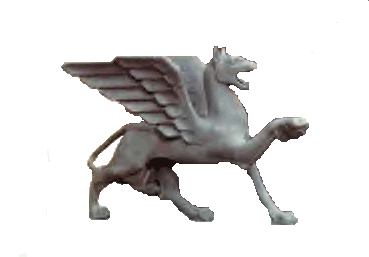
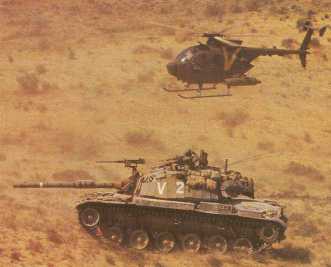
 Griffon: A fabulous animal, symbolically significant for its domination of both the earth and the sky - because of its lion's body and eagle's head and wings. It has typological
antecedents in ancient Asia, especially in the Assyrian k'rub, which is also the source of the Hebrew cherub. The frequent representations of griffin-like creatures in
Persian art made them symbolize ancient Persia for the Jews. In Greece, the griffin was a symbol of vigilant strength; Apollo rode one, and griffins guarded the gold of the Hyperboreans
of the far north. The griffin was also an embodiment of Nemesis, the goddess of retribution, and turned her wheel-of-fortune. In legend, the creature was a symbol of superbia
(arrogant pride); because Alexander the Great was said to have tried to fly on the backs of griffins to the edge of the sky. At first, also protrayed as a satanic figure entrapping human
souls, the creature later became (from Dante onward) a symbol of the dual nature (divine and human) of Jesus Christ; precisely because of its mastery of earth and sky. The solar associations
of both the lion and the eagle favored this positive reading. The griffin thus also became the adversary of serpents and basilisks, both of which were seen as embodiments of satanic demons.
Even Christ's Ascension came to be associated with the griffin. The creature appeared as frequently in the applied arts (tapestries, the work of goldsmiths) as in heraldry. In the latter domain,
Boeckler (1688) offered the following interpretation: "Griffins are protrayed with a lion's body, an eagle's head, long ears, and an eagle's claws, to indicate that one must combine intelligence
and strength."
Griffon: A fabulous animal, symbolically significant for its domination of both the earth and the sky - because of its lion's body and eagle's head and wings. It has typological
antecedents in ancient Asia, especially in the Assyrian k'rub, which is also the source of the Hebrew cherub. The frequent representations of griffin-like creatures in
Persian art made them symbolize ancient Persia for the Jews. In Greece, the griffin was a symbol of vigilant strength; Apollo rode one, and griffins guarded the gold of the Hyperboreans
of the far north. The griffin was also an embodiment of Nemesis, the goddess of retribution, and turned her wheel-of-fortune. In legend, the creature was a symbol of superbia
(arrogant pride); because Alexander the Great was said to have tried to fly on the backs of griffins to the edge of the sky. At first, also protrayed as a satanic figure entrapping human
souls, the creature later became (from Dante onward) a symbol of the dual nature (divine and human) of Jesus Christ; precisely because of its mastery of earth and sky. The solar associations
of both the lion and the eagle favored this positive reading. The griffin thus also became the adversary of serpents and basilisks, both of which were seen as embodiments of satanic demons.
Even Christ's Ascension came to be associated with the griffin. The creature appeared as frequently in the applied arts (tapestries, the work of goldsmiths) as in heraldry. In the latter domain,
Boeckler (1688) offered the following interpretation: "Griffins are protrayed with a lion's body, an eagle's head, long ears, and an eagle's claws, to indicate that one must combine intelligence
and strength."
Several U.S. Army units like the 12th Aviation Brigade already use the Griffon as their mascot.
Introduction
Studying Rhodesian FIRE FORCE tactics from 1962-1980, you realize that they were using AIRmechstrike at the very small unit level.
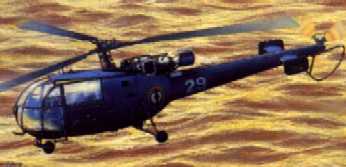
 scribd.com/doc/50357092/Counter-Insurgency-in-Rhodesia
scribd.com/doc/50357092/Counter-Insurgency-in-Rhodesia
http://ourworld.compuserve.com/homepages/RAllport/firefor1.htm
4-man fire teams were transported in small Alouette III turbine helicopters backed by another Alouette III with a 20mm cannon or quad 7.62mm MMGs. As they set-up into blocking positions, C-47 Paradaks would drop a stick of 16 Paratroopers to flush the enemy into the stop group's ambush positions. The light helos would fly overhead looking for any sign of the nemy to include tracks around trees where they relieved themselves---once spotted, the enemy was hit with fires and either killed there or flushed out into the open and killed by air or ground fires---a superb SENSOR/SHOOTER interface. What struck me about it all was how the tiny helicopters were working in close coordination with the fire teams and how they were burning up fuel at an incredible rate. They had to push forward caches of fuel in advance of operations just to keep their "G" and "K" cars flying.
Thinking of this, it seems the fuel cost was for keeping the Alouette IIIs nearby---if they landed they became vulnerable and unable to contribute to the fight, so the engines had to stay on at all times. If you go to Ft.Bragg, NC today you will hear the engines of OH-58D Kiowa Warrior scout helicopters running all the time, even if they are on the ground hiding behind the trees for a target to appear for them to pop up and see with their mast mounted sight (MMS). A smart enemy will not allow you to stage (Forward Arming And Refuelling Points) FAARPs in their own territory to enable continuous/long-range helicopter operations.
If these operations were being done by today's German Paratroops, they'd CH-53G helicopter-in their specially-made-to-fit-INSIDE-helicopters-Wiesel or Mini-Gavin ultra-light Armored Fighting Vehicles to act as on-the-ground fire support and in the future troop transports that can stay there for extended periods of time. A ground vehicle can even turn its engines off and still contribute to the fight. Its costly to buy/maintain both ground/air vehicles and even the Germans have yet to obtain Wiesel 2 troop carrying AFVs due to money shortages.

Step 1---START VERY SMALL: Carry Flying ATVs & Bikes With your Troop-Carrying Light Trank
Step one towards creating a "flying jeep" would be to take a folding mountain bike or a 4-wheeled ATV and combining it with a rear fan and a ram-air parachute or an autogyro set of rotor blades. In fact, Ted Strong of Strong's Parachutes recently combined a RAP with the ATV and made test parachute insertions:
However, there is a 15 mph adversarial wind limit to powered parachute operations; an autogyro can fly even in the face of such strong winds.
 ATBs, ATVs & Dirt Bikes + Armored M113 Gavin Light Tank "Mother Ships"
ATBs, ATVs & Dirt Bikes + Armored M113 Gavin Light Tank "Mother Ships"
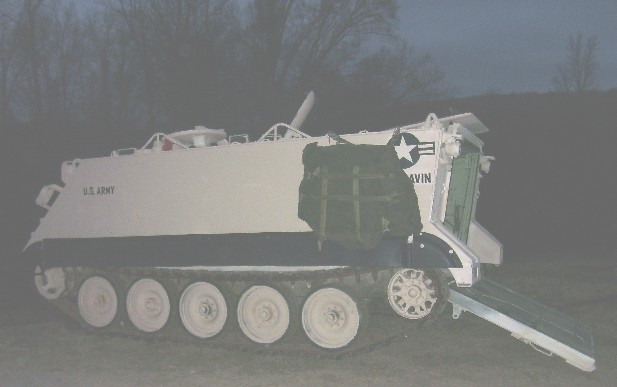
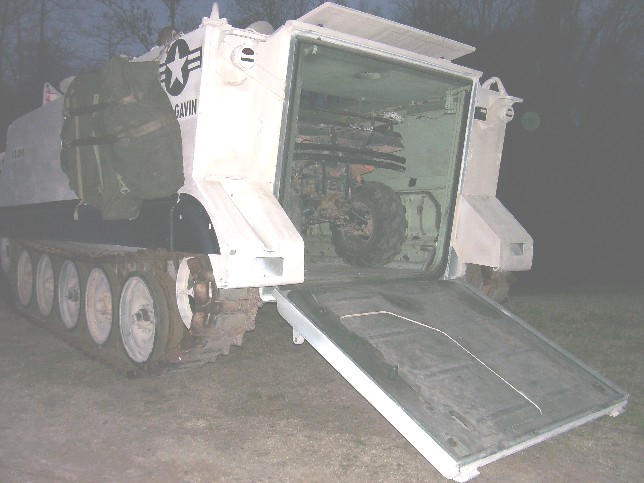
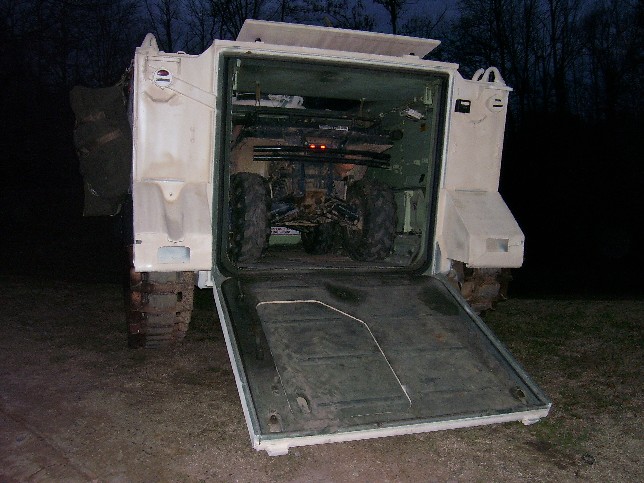
A remarkable 1st TSG (A) discovery is that not only can folded and unfolded ATBs fit INSIDE M113 Gavin light tanks, so can motor dirt bikes and a 4x4 ATV. The idea came from pictures of the Australian Army during the Vietnam war placing 105mm light howitzers inside their M113 Gavins to effect greater cross-country mobility than trying to tow them on their wheels through the soft, muddy terrain there as well as concealing to the enemy what capabilities they were delivering.
diggerhistory.info/pages-conflicts-periods/ww1/lt-horse/4-19-pow-lt-horse.htm
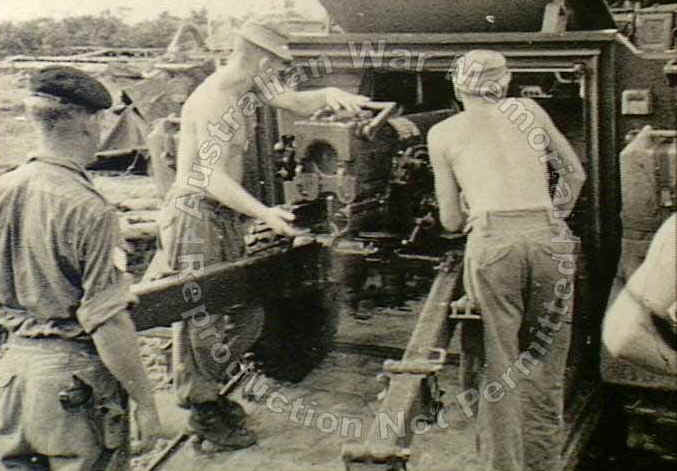
CAPTION: Bien Hoa, South Vietnam, 1965-08-18. Gunners of 161 Field Battery Royal New Zealand Artillery, manhandle a 105mm L5 pack howitzer into a M113 of 1 APC troop, Prince of Wales Light Horse, as the battery prepares to move to a temporary firing position six kilometres north of Bien Hoa airbase. The guns of 161 Fd Bty were carried to the firing site inside APC's to conceal the nature of the operation. This was the first occasion that the L5's of 161 Fd Bty were carried inside APC's. (donor H M. Lander)
Hunnicutt's book on American infantry fighting vehicles shows a jeep rolling off from inside a humongous M59 armored personnel carrier as well as photos of British General Percy Hobart's 79th Armoured Division in WW2 transporting jeeps and Bren gun APCs inside LVT-4 Buffalo amtracks across rivers under enemy fire in WW2. This gave us the idea to experiment with an ATV and dirt bike with a M113 Gavin. This capability is not possible in Stryker (an ATV can't fit and they don't swim) or Pandur (an ATV can't fit) wheeled trucks. Removing the track commander's (TC) stand from inside the M113 frees up enough space for a 4x4 ATV like the new safe diesel-powered military model made by Polaris or 3 military dirt bikes--on top of the up to 10 x folding ATBs that can be carried on the outside in Cashwell airdrop bags.
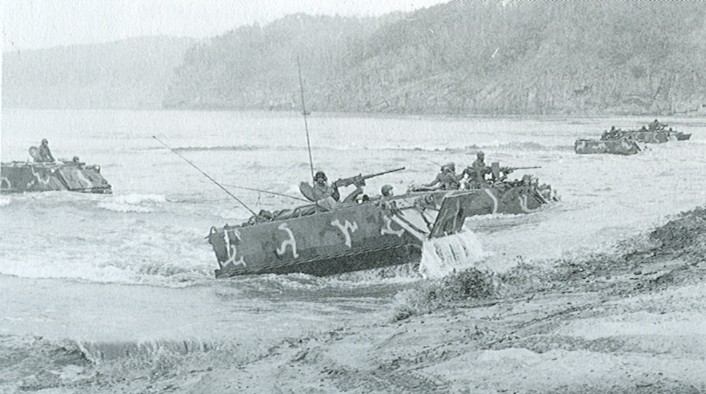
 youtube.com/watch?v=MfzjqY0Pq3c
youtube.com/watch?v=MfzjqY0Pq3c
The Gavin's armored hull and amphibious, tracked mobility then protects these scout vehicles from enemy fires and land mines (The Battle Against Man-TBAM) while conveying them over terrain and water they cannot traverse (The Battle Against The Earth-TBATE) to the desired area of operations.
Loading an 4x4 ATV into a M113 Gavin Light Tank
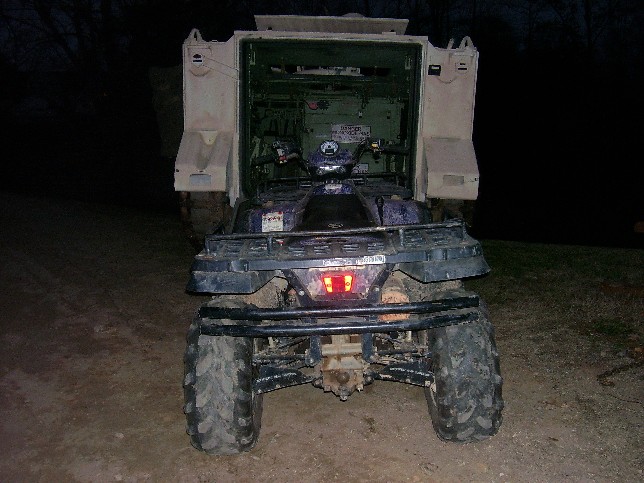
2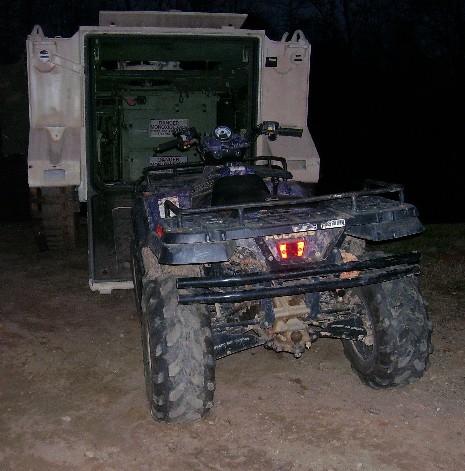
3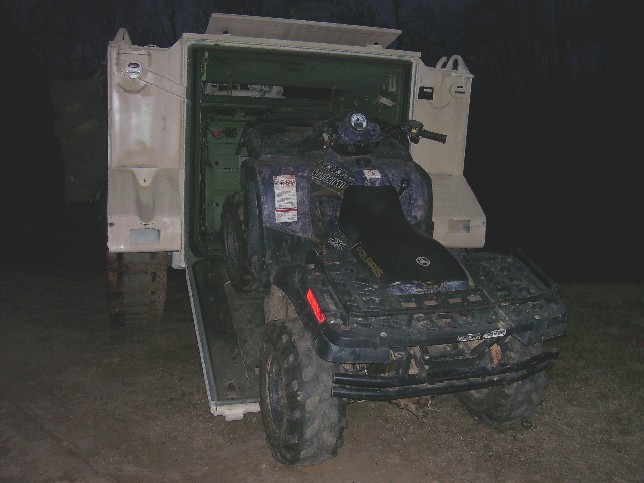
4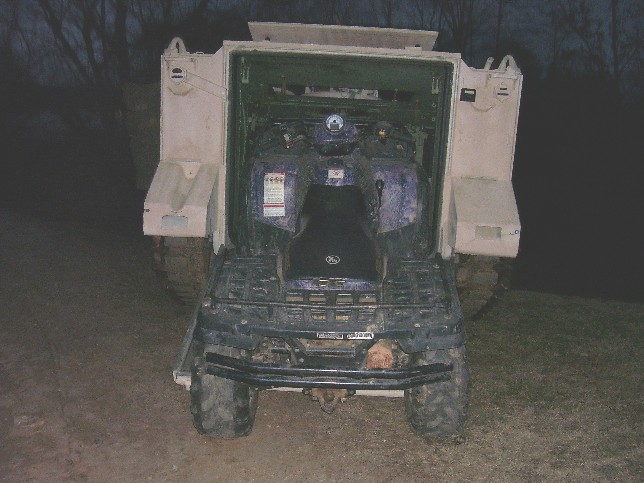
5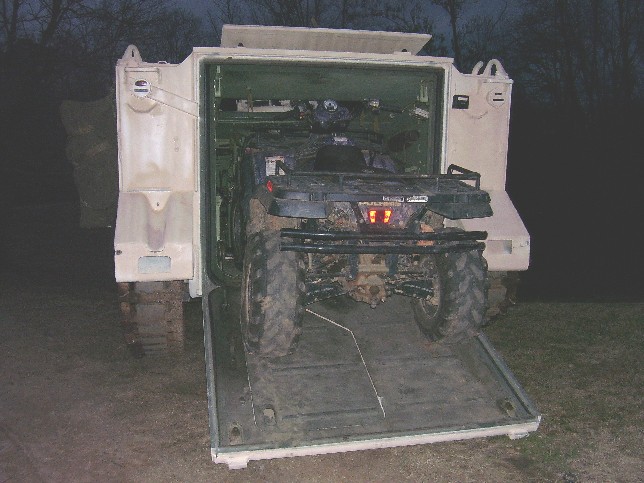
6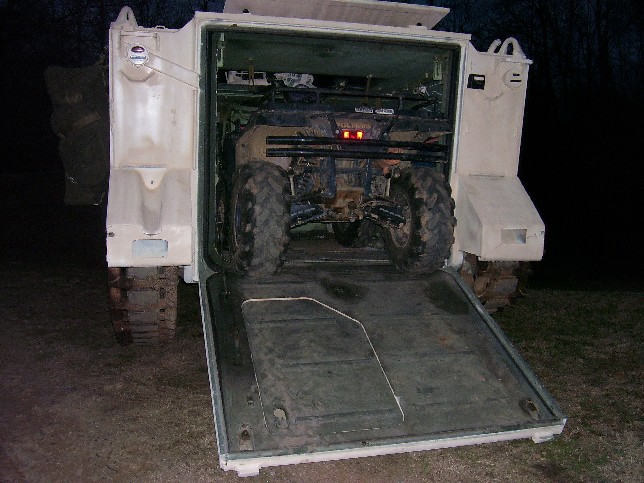
7 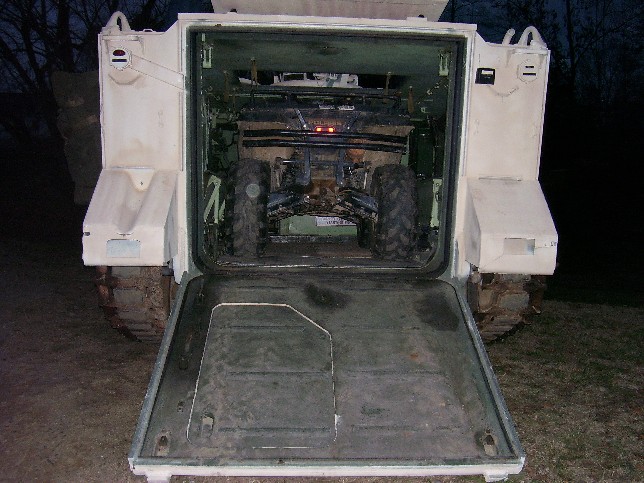
8 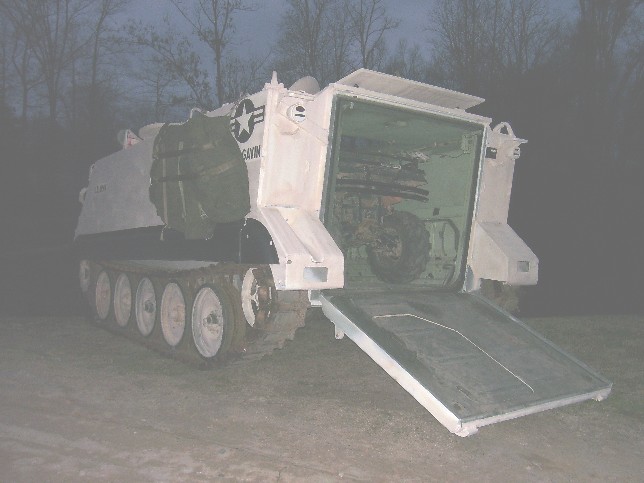
After the ATV is inside, the TC can sit or stand on its front or rear (depending on how you load it) to operate the 360 degree spinning cupola with mount for a light, medium, heavy machine gun or autocannon like the ASP-30mm.
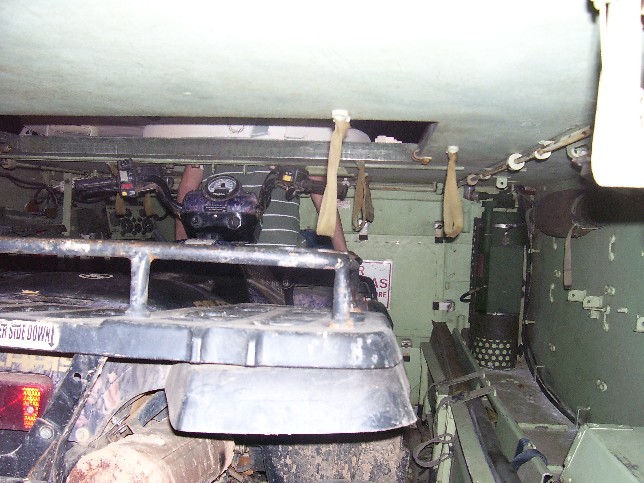
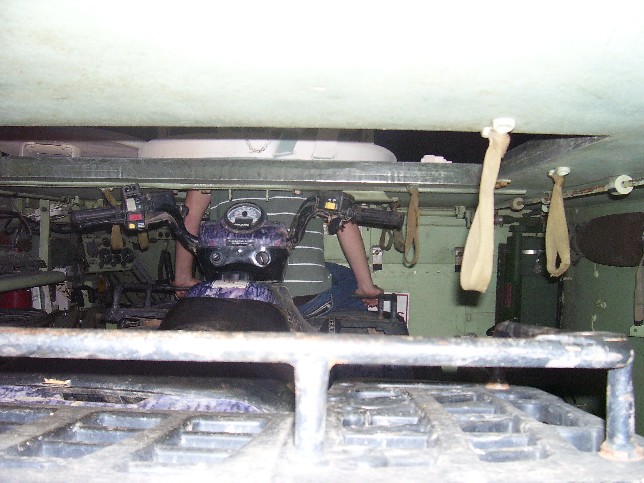
M113 Gavin + ASP-30mm Autocannon-in-action VIDEO
 youtube.com/watch?v=9SPHgpLWPws
youtube.com/watch?v=9SPHgpLWPws
Dirt Bike Loading into a M113 Gavin Light Tank
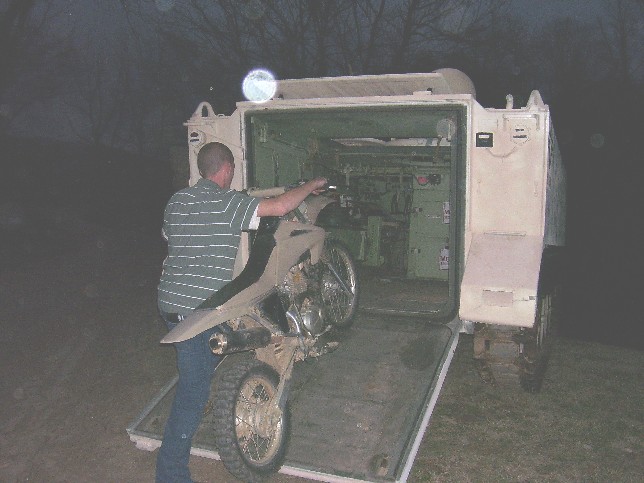
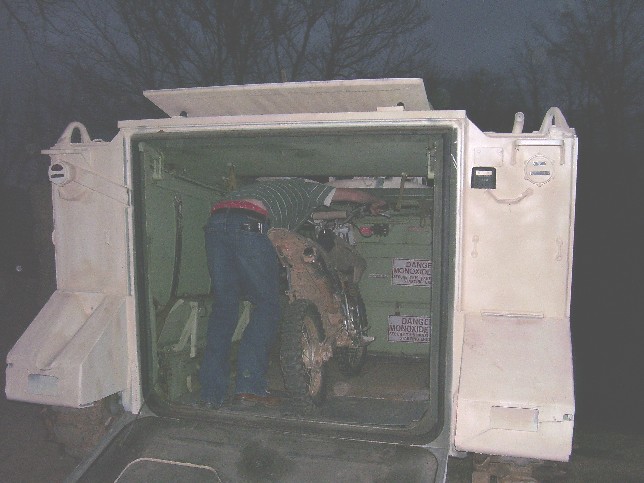
LBI Electric AeroBike Scouts
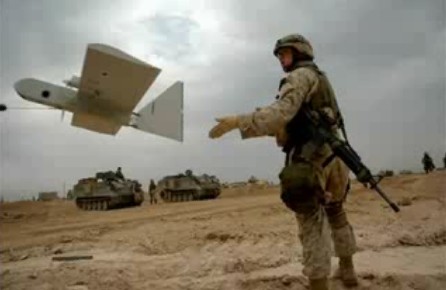
A Canadian Csaba Lemak has created an electric-powered ram-air parachute to fly one man in winds up to 15 mph. Such devices could be easily carried inside or strapped outside in bags of M113 Gavins and LBI "AeroBike" Scouts could fly them to perform air recon just as unmanned UAVs could be operated. Powered parachutes and ultralights powered by gasoline fossil fuels are easily possible in conjunction with mother M113 Gavin tanks, but these fuel are dangerous and would have to be stored in 5 gallon cans. An excellent ATV that FLIES and could fit inside a M113 Gavin is the new Chimera air/ground vehicle!
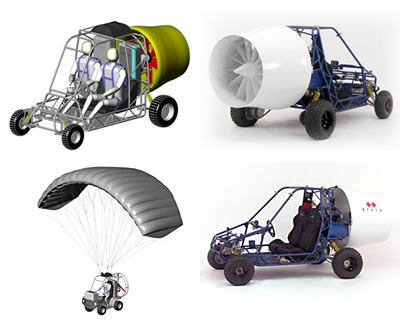

atairaerospace.com
Key Features of the Chimera:
Air-droppable from a C-17, C-130, or other platform using an integrated parachute system
Ground-launchable using the largest elliptical paraglider ever constructed-100 ft wing span
Ducted fan propulsion
3-Cylinder, 110 Hp, liquid-cooled engine
Hybrid-electric drive
80 Peak Hp electric wheels motors
Max takeoff weight: 2200 lbs
Dry weight: 970 lbs
Ground speed: 60 mph
Air speed: 30 kts
The new Polaris ATV and dirt bikes powered by diesel/JP-8 can use the same fuel as the Gavin uses. If the ATB and/or the fan unit were ELECTRICAL motor driven then the Gavin could charge both their lithium-ion batteries when its engine is operating. Pedal/electric ATBs and powered paragliders (PPGs) would be silent and very mobile in both 2D/3D forms of movement to be able to spot the enemy first and develop the situation from there. If while flying the electric PPG, the pedal/electric ATB is underneath ready-to-ride, it becomes an air/ground vehicle system. Perhaps by integrating the electrical motor/fan and batteries INTO THE ATB, the Li-on batteries can power the fan unit in the air and a rear hub motor on the ground with the AeroScout's pedaling helping recharge the batteries whenever possible.
 youtube.com/watch?v=iVN_qEtBqjg
youtube.com/watch?v=iVN_qEtBqjg
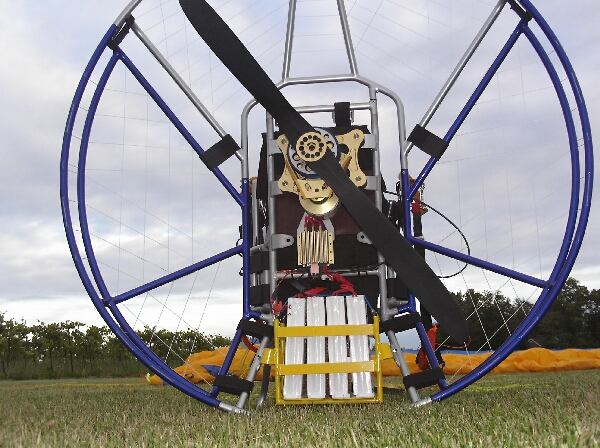
www.lightsportaircraft.ca/airventure-2006/electricpowered-poweredparaglider.html
ultralightstore@ultralightnews.ca
What's a watt?
The watt (W) is a measure of power. Power is the ability to produce force at some speed or RPM. Although the more familiar unit of power used for engines is horsepower (hp), electric motors measure their power in watts.
Don't confuse torque with power. Torque is a force, like how much pressure you must exert to get a screw out. Power is twisting against some torque through some number of revolutions per minute.
746 watts is the same as one hp. Some interesting comparisons of watts:
• A human being climbing a flight of stairs is doing work at the rate of about 200 watts.
• A trained athlete can work at up to 900 watts for short periods.
• A car engine produces work at a rate of around 100,000 watts.
An incandescent light bulb uses 40 - 100 watts.
AeroBikes
slideshare.net/1st_TSG_Airborne/paraglider-folded-bike-v10
Assuming a sky-camouflage colored parachute, power unit and jumpsuit worn by the LBI Aeroscout....
a. Is it feasible eventually to generate enough electrical power to add a 30 pound pedal mountain bike to its payload?
b. Would it be then feasible to attach the electric rear fan unit to the rear of the mountain bike and have the motor that spins the prop to also spin the rear wheel without excessive weight?
c. If not, at least give the whole unit ground mobility by pedal power....
During a 1-hour flight at 25 mph can the LBI AeroScout pedal and generate with his 1/2 a horsepower meaningful recharging of the batteries to keep him aloft?
If not, how much pedaling on the ground ostensibly doing ground movement would it take to rejuvenate his batteries for flight?
Say his parachute was 20 feet wide and 5 feet wide for a total of 100 square feet, could meaningful battery charging take place during his 1 hour flight if solar photovoltaic cells covered the top of his parachute?
How long would it take to recharge his batteries if the parachute was laid on top of the ground and staked into position there?
How long would it take to recharge the AeroBike's batteries if it was strapped to the outside of a M113 Gavin light tracked AFV that had as it ran an AC converter?
Flying Machines Deployed from Ground Vehicles

In the Raymond Benson James Bond fiction series, he has 007's car equipped with a small unmanned air vehicle with which to do recons and attacks--not unlike Speed Racer's mechanical bird.
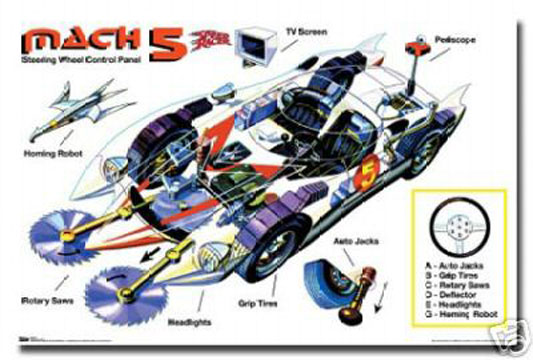
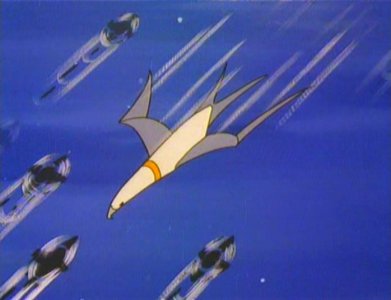
What would an U.S. Army tank be like that had a specially-designed, manned observation/attack aircraft integral to it?
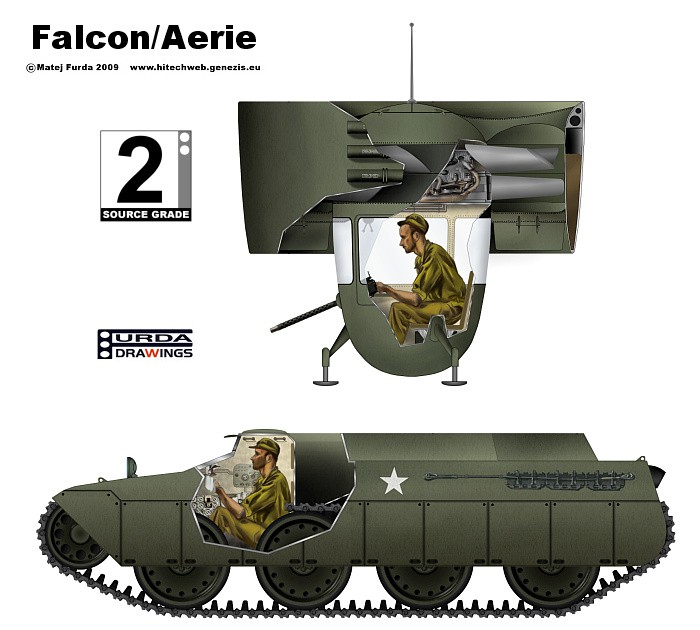
Special thanks to:
http://stingraysrotorforum.activeboard.com/t50592408/flying-tank-turrets/
secretprojects.co.uk/forum/index.php/topic,677.0.html
Skybolt, you are reading my brains - just was going to post it.The Ordnance Tank Automotive Command (OTAC) presented two programs in response to the requirements of the ASTRON project. The first was based on technology that was only slightly advanced beyond what was available at that time, while the second program utilized a level of technology that could be expected by 1962, provided that high priorities were placed on the development of certain components.
The first program consisted of proposals for a new medium gun tank and 2 specialized combat vehicles. The latter were a 10-ton airborne light tank and a one man armored reconnaisance aircraft with a tracked carrier. As presented on 17 May 1955, the medium gun tank was referred to as the Rex. Later, it was redesignated as the Rex I after the development of subsequent versions.
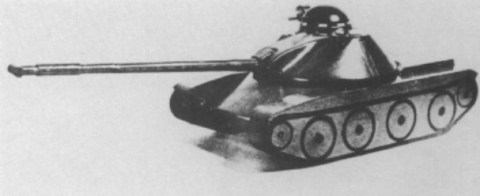
The Rex tank incorporated many of the features included in some of the earlier proposals. The driver was located in the turret with the gunner and the tank commander. The turret ring was only 80 inches in diameter, but this provided ample space since an automatic loading device replaced the loader reducing the crew to three men. The gunner and tank commander were in their usual positions on the right side of the rigidly mounted modified 90mm gun T208 and the tank commander was provided with a cupola armed with a [7.62mm medium] .30 caliber machine gun. This was part of an integrated commander's station including an Optar range finder, a sight, and an automatic target designation system. The latter held the cupola and its sight on a target while the turret and gun were traversed and brought to bear on the same target. The correct superelevation was automatically applied to the main armament during this operation. The 90mm gun T208 was modified to use combustible case ammunition eliminating the need for a case ejection mechanism and simplifying the design of the automatic loader. This loader was supplied by a 14-round rotary magazine underneath the turret basket floor which could be reloaded when needed by the tank commander or driver. The estimated maximum firing rate with the automatic loader was 28 to 30 rounds per minute. A coaxial .50 caliber machine gun was mounted on the left side of the cannon and an articulated telescopic sight was located on the right side for the gunner. No stabilization was provided for the main armament.
The driver was seated on a platform suspended from the roof in the left front of the turret. His seat was hydraulically adjustable between a low position for use when the hatch was closed to a high position for operation with the driver's head exposed. A gear train rotated the driver's platform so that he always faced forward regardless of the turret position. The linkages for the driver's controls were actuated by electrical signals transmitted through slip rings. The turret location provided the driver with a greatly increased field of vision allowing him to maneuver the tank even in reverse without aid from another observer. He also was less vulnerable to dirt and water splash as well as mine explosions. Protection for the entire crew compartment against chemical, biological, and radiological (CBR) attack was provided by a single unit so that the wearing of individual masks was not required.
The front of the turret and hull was protected from attack in the 60 degree frontal arc by siliceous-cored armor. This armor was effective against shaped charge rounds up to 100mm in diameter. Against armor piercing kinetic energy projectiles, it was equivalent to 4.8 inches of homogeneous steel armor at 60 degrees from the vertical. The combat loaded weight of the Rex was estimated to be 31 tons and it was to be powered by a transversely-mounted Continental AOI-628 engine with the XTG-400 transmission. This version of the engine was expected to deliver a maximum of 350 gross horsepower. The flat track, torsion-bar suspension had four dual road wheels per side with 19 inch wide tracks. The driver-in-turret design resulted in an overall height of only 95 inches for the Rex. The width was 126 inches and the overall length with the gun forward was 348 inches.
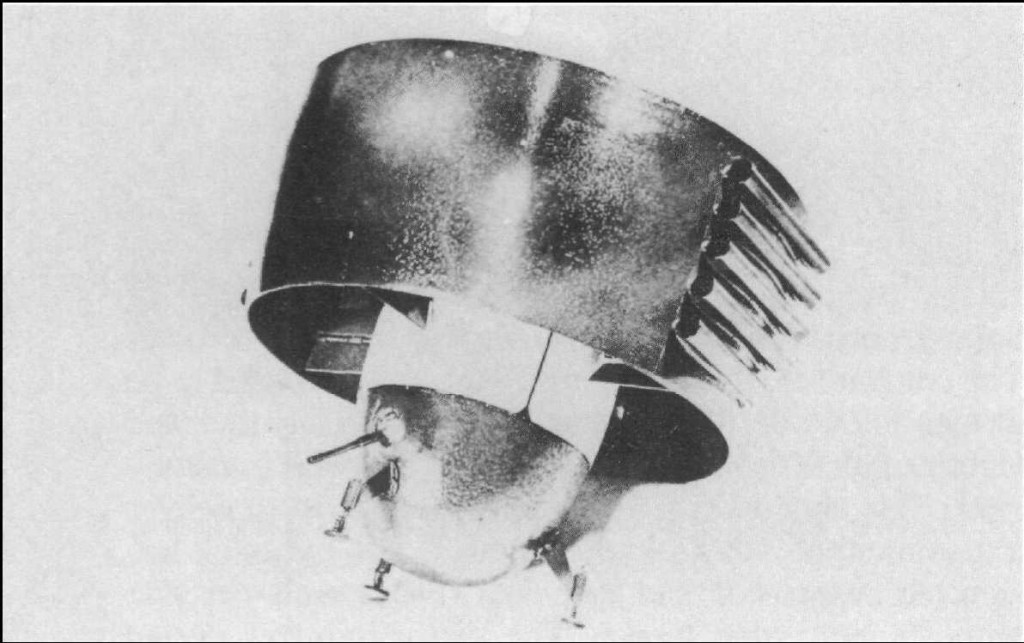
The most radical of all of the proposals under the first OTAC program was the 1-man, armored reconnaisance aircraft. A vertical take off and landing vehicle with the flying characteristics of a helicopter, it was designed to be carried by and launched from a tracked carrier based on the Rex tank. The aircraft portion of this combination was called Falcon and the tracked vehicle was appropriately named Aerie.
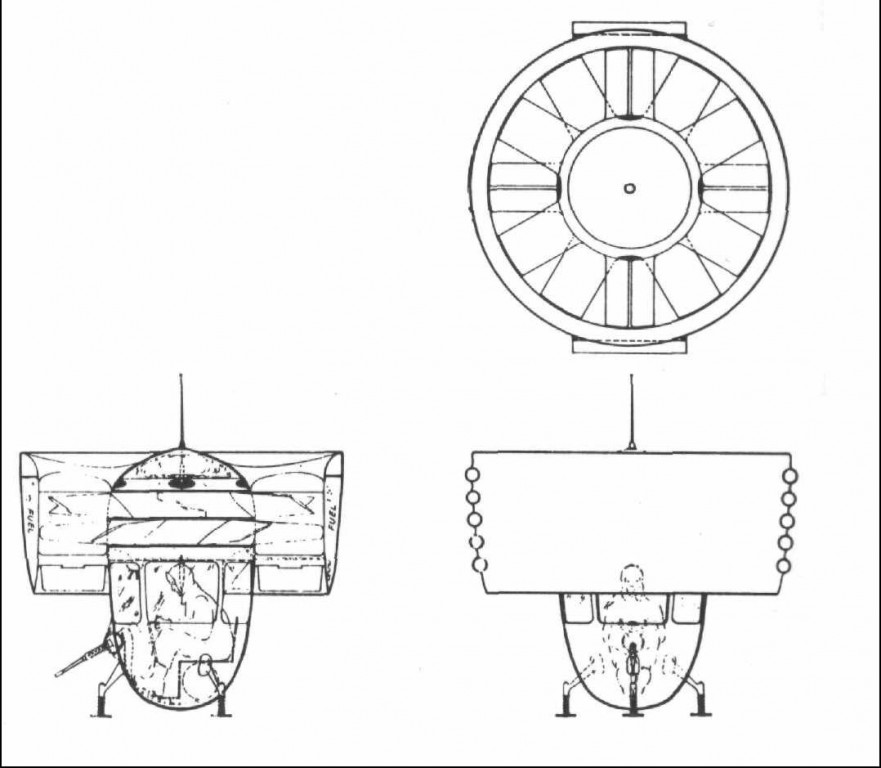
Powered by an aircraft radial engine, the 113-inch diameter flying vehicle was protected by 1" inch thick titanium armor. Armed with ten 4.5 inch free flight rockets and a [7.62mm] .30 caliber [medium] machine gun, the estimated weight of the Falcon was 3,000 pounds. Its speed range was calculated to vary from 0 (hover) to 100 miles per hour with an endurance of about one hour. An emergency parachute installed at the top center of the aircraft was expected to be capable of providing a safe landing from an altitude as low as 100 feet.
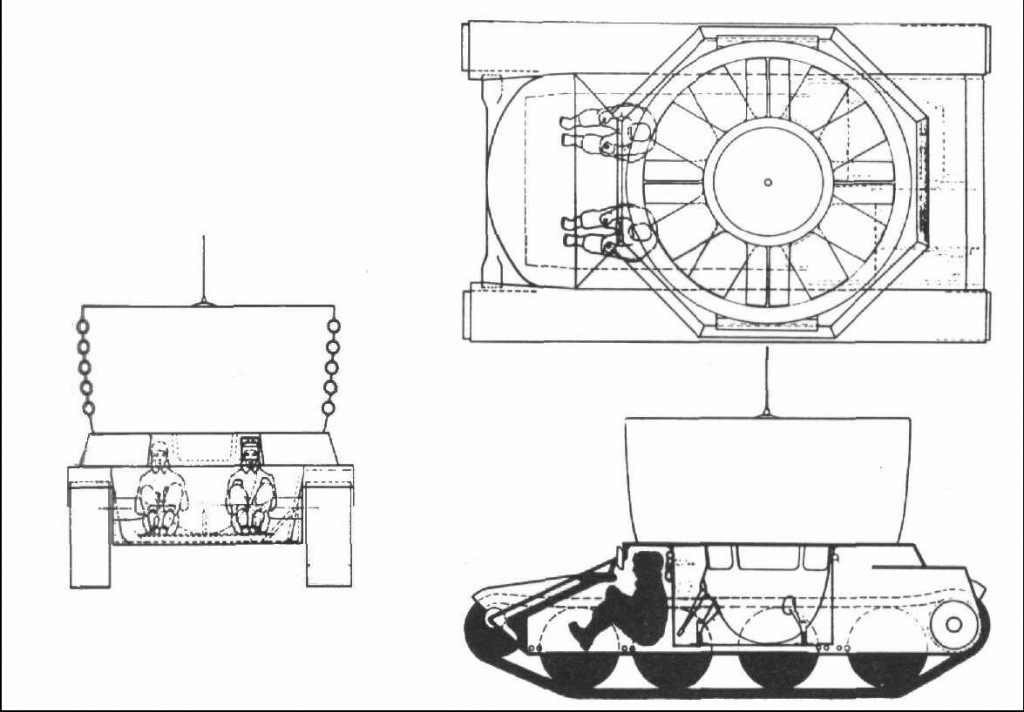
The Aerie carrier alone was estimated to weigh 20 tons with space in the front hull for a 2-man crew. It was fitted with a hydraulically retractable take-off platform for the Falcon.
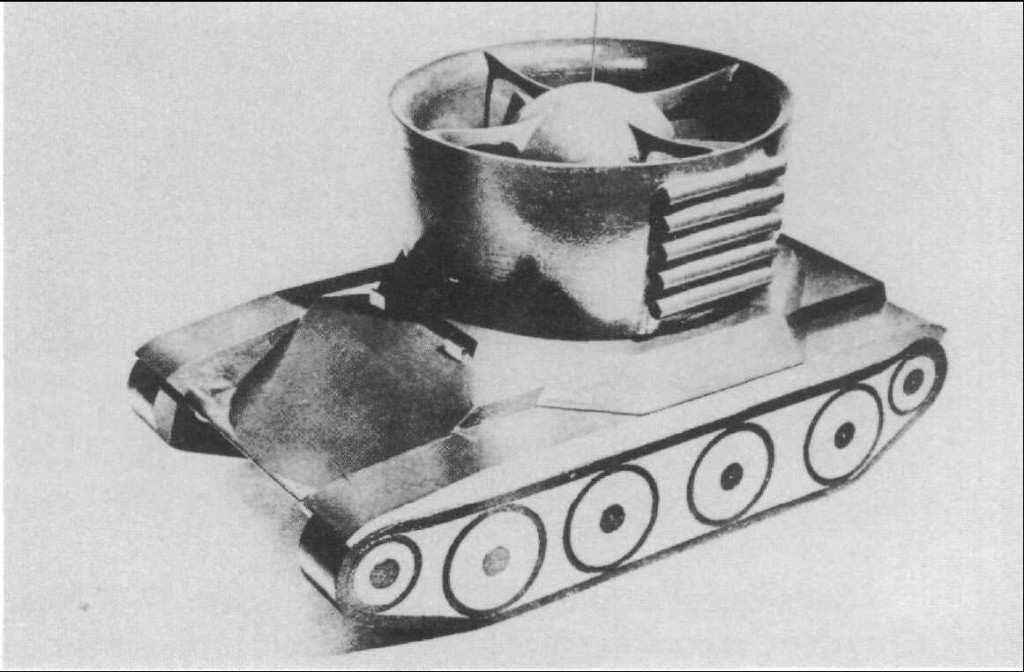
The essence here is that ground forces need "Killer Bees" in their hip pockets--not hundreds of miles away at a comfy air base.
Step 2--START SMALL: Flying Jeeps: Hafner's AutoGyro Gliders in WW2
ROTARY-WING
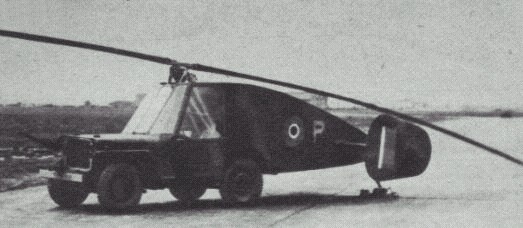
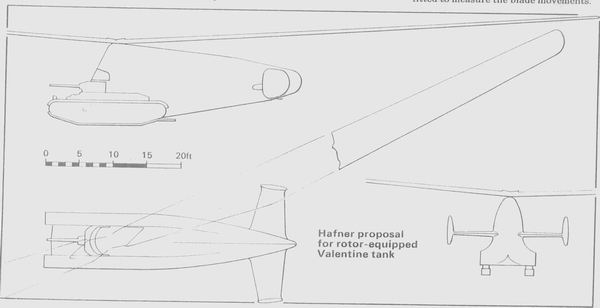
Hafner's Jeep and Valentine medium tank with rotors to be towed in flight
 youtube.com/watch?v=8TVilGERRAo
youtube.com/watch?v=8TVilGERRAo
In WWII, the un-powered "flying jeep" or "fleep" was created to be towed behind another aircraft and air-inserted. The "Autobuggy" could only reach 72 mph with its rotors, too slow for the tow aircraft so it was dropped.(See details on bottom of this page). But had the inventors been a little more daring, they could have driven a rear propeller from the jeep's engines---not unlike how the DD swimming Sherman tanks were able to have a rear propeller added. Then the "flying jeep" could have been the first Air/Land combat vehicle that could go from air to ground movement using its own means. If you see the latest James Bond, 007 film, "The world is not enough", you will see an Air/Land vehicle, the Parahawk which is a rear fan snow mobile that flies by a large Ram-Air Parachute (RAP).
ultraflight.com/issues/nov99/nov99page27.htm
 http://il.youtube.com/watch?v=58ADcUthPdo
http://il.youtube.com/watch?v=58ADcUthPdo
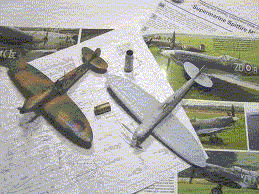 BUILD-A-MODEL
BUILD-A-MODEL
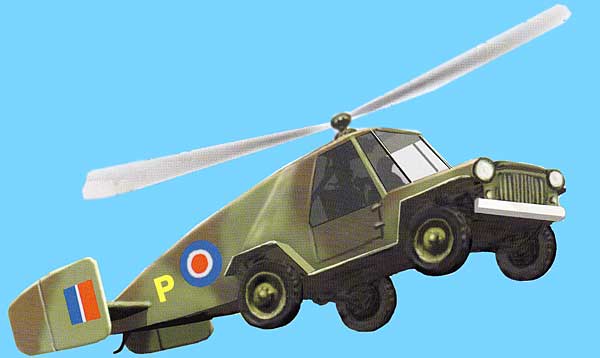
fiddlersgreen.net/models/aircraft/Flying-Jeep
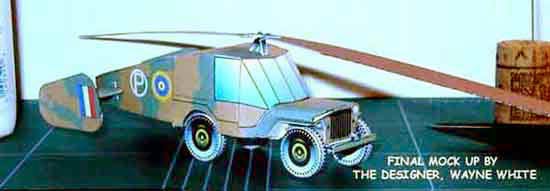
Flying Jeep
One of the many experiments undertaken in World War II to increase battlefield mobility by the provision of rotary wings for men and vehicles, the Hafner Rotabuggy was intended as a stepping-stone to a flying Valentine medium tank. $5.50
FIXED-WING
Soft Ram-Air Parachutes (Can Compress)
i-Tec's Flying Dune Buggy
 youtube.com/watch?v=7INsC6Ts3qc
youtube.com/watch?v=7INsC6Ts3qc
Hard Wings (Must Fold or Detach)
 youtube.com/watch?v=QqzN2zqJilI
youtube.com/watch?v=QqzN2zqJilI
Scene from The Man with the Golden Gun (TMWTGG); 007 played by Roger Moore encounters villains who escape--with Mary Goodnight-- using a jet-powered flying car. Feasible.
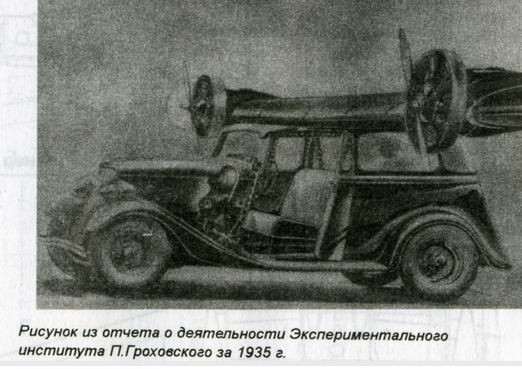
Russian Grohovskiy G-26 (Attempt at creating a flying car)
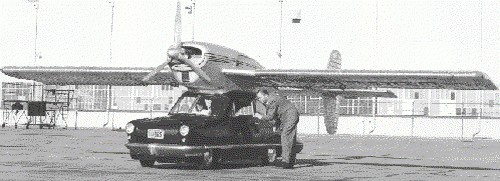
Robert Fulton's "AirPhibian" so far has been the most successful wheeled/car airplane combination. Legendary OV-10 Bronco creator, retired USMC LTC K.P. Rice is developing his Volante air/ground vehicle today that with GPS and a host of family farms participating could enable car/planes to land in event of bad weather or reaching their destination to switch into ground-mobile mode without having to work around the bottlenecks and bureaucracy of small airports.
THE AirPhibian HISTORY
 youtube.com/watch?v=aK5HK-7hPTE
youtube.com/watch?v=aK5HK-7hPTE
SEE AN Aerocar IN ACTION!
 youtube.com/watch?v=lrc7t0pTYR0
youtube.com/watch?v=lrc7t0pTYR0
 BUILD-A-MODEL!
BUILD-A-MODEL!
fiddlersgreen.net/models/aircraft/Aerocar
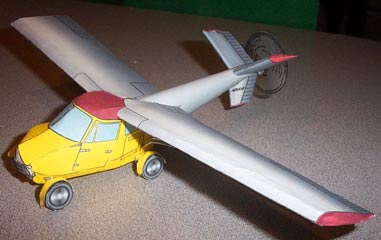
Taylor recognized that the detachable wings of Fulton's design would be better replaced by folding wings. His prototype Aerocar utilized folding wings that allowed the road vehicle to be convertible into flight mode in five minutes by one person. Aerocar - $5.95
And the Magnificant TerraFugia Transition Aerocar that also folds its wings!
 youtube.com/watch?NR=1&v=iE2Ij7Rfw1Q
youtube.com/watch?NR=1&v=iE2Ij7Rfw1Q
What's amazing about the Transition is that it not only converts to ground car mode at a push of a button, it has air bags, a crash crumple zone and safety cage so its safe on the ground in event of a collision. And in the air, it has a ballistic recovery parachute to safely descend to the ground in event of an engine failure! Combine this with its ability to land in the face of bad weather and continue on the ground, it is potentially the safest aircraft, ever made.
And, Today's Volante!
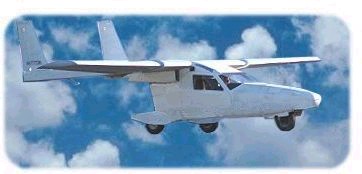
 youtube.com/watch?v=qfQ4a45LNqw
youtube.com/watch?v=qfQ4a45LNqw
volanteaircraft.com/articles/revolutionizing-aviation.doc
THE FLYING CAR CAN REVOLUTIONIZE PRIVATE AVIATION
When most people think about a flying car, they think about the convenience of door-to-door travel which such a machine might bring to their lives, and about the $400 hangar rent they could save by keeping it in their garage.
Above and beyond these not insignificant speculations, what is not readily apparent is the potential of the flying car to bring about a revolution in private aviation, which could, in time, make flying as useful and as common as driving is today - that is, to finally bring about the old NACA dream of an "airplane (flying car) in every garage."
In other words, instead of resting in the hands of a few, as it does today useful aviation can be brought to everybody. How and why this can happen is the subject of this paper and the presentation is divided into three parts:
- First, I'll show you how the unique qualities of a flying car make this revolution possible and how such a development would solve many of the big problems general aviation is battling with today
- Next I'll walk you through a possible scenario, one out of many, by which the inexpensive flying car we need to do this can become a reality
- Lastly I'll take you to a 20XX suburban setting to see what an integrated automobile/aircraft world would bring to our lives.
Starting with No. 1-- for context, first we'll analyze and contrast the automobile and the light aircraft to see where we are currently, what is OK and what needs fixing. First, then, let's look at the principal qualities associated with an automobile that make it so popular and necessary in our lives today and compare this with today's light airplane.
Looking at cost and usefulness:
An automobile can be purchased, new or used, for a price that is affordable to the average family and, within pretty broad limits, it will dependably take that family anywhere it wants to go in all types of weather. It also does this with training and skill levels well within the norm of the average driver.
In contrast, the airplane generally costs more than any but the upper middle class or totally dedicated individual can afford. It has the capability to get you to your destination faster than the automobile, if the distance is long enough, but it will not do this in all weather conditions unless YOU HAVE AN INSTRUMENT RATED AIRCRAFT AND A CURRENT, INSTRUMENT RATED PILOT. The cost, time, and skill required to obtain and maintain these instrument credentials are well beyond the reach of the average person. Try to imagine how may cars would drive through weather if doing so required expending the equivalent cost and time, not to mention skill, required by instrument flight.
Summarizing the above, what is missing from private aviation and prevents it from growing (in fact, the pilot population is shrinking) is the affordable aircraft at close to an automobile price today and a less complex and inexpensive way to get through weather that is within the means and skills of the average person.
If you are up in arms already defending the sport flyer and the LSA program, don't be. These are both great programs, but they won't get you where I am going. Please read on.
So much for automobiles and today's light aircraft. What is it that justifies my opening statement about flying cars revolutionizing the transportation system?
It is this: THE FLYING CAR IS UNIQUE IN THAT IT IS ALREADY A CAR WITH ALL THE PREVIOUSLY MENTIONED DESIRABLE QUALITIES AND IT IS ALSO AN AIRPLANE. It incorporates the best qualities of both the car and the airplane. It gives us the dependability of the car and the speed of the aircraft, with VFR operability at the average individual's skill level.
The flying car can drive to the airport, depart from there VFR, run into weather en route, land, and drive through it to the nearest airport, take off again, and proceed to the destination airport, land, and drive to the real final destination - all VFR. It functions with all of the advantages of an aircraft in good weather and becomes a dependable car to operate in bad weather. NO OTHER MACHINE CAN DO THIS.
Before we talk about the other hurdle, cost, I want to say a few words about VFR. What do I think we know about VFR flying?
- It is fun. The view is fantastic, and it can make the heart almost burst with the joy of flight, in contrast to IFR with your eyes glued to the instrument panel.
- It is within the skill level of about everybody.
- A lot of aircraft can operate in close proximity flying VFR. In my early days in the Navy training command, we used to taxi 75 aircraft in a line to a large grass field, where the pilots lined up along one edge abreast and into the wind. We didn't have radios, just a tower with light signals. When it was your turn, a green light launched you into the air, frequently two or three abreast or very slightly staggered. The sky was full of airplanes, and none of us felt threatened. On return, the entire gaggle arrived more or less over a pre-selected - that is, prominent ground feature - point A, took interval as necessary, and landed - again, often abreast or very slightly staggered, several on run out at the same time.
The modern counterpart, albeit with radio control, is the Oshkosh sky at arrival time. Hundreds of aircraft can operate in close proximity with minimum of external discipline if the pilots are trained and expect to do this. The sky becomes much like a California freeway, where bumper-to-bumper and side-by-side automobiles travel at up to 80 mph, with only very, very few severe accidents.
- VFR travel is less frequent today, except among sport pilots, because flight has evolved toward IFR, just because of the increasing complexity of the airspace divisions that have made it about as easy to be in constant contact with ATC as it is to figure out when you should contact them on a mandatory basis. This doesn't detract from the fact that VFR is still a much more pleasant and much simpler way to travel, and with appropriate regulation on airspace allocation a return to this mode of travel is not only desirable but may be forced by the saturation of ATC facilities.
- The training required to solo, and then to go cross-country as sport plane regulations spell it out, is only a fraction of the cost and time required by instrument flight, as is the skill level required. It is probably about the same time as required for driving a car safely. In contrast with IFR operations, there is practically no limit to the number of airplanes that can be airborne simultaneously, as is the case under the air traffic control system for IFR, often saturated in certain areas even today.
- Regarding safety, let's face this head on. We kill 30,000 people annually in auto accidents, and injure countless others. Would not substituting flying for driving increase the number astronomically? I don't think so, as we will take a lot of cars off the highway on their longer flying trips, and with three dimensions to travel in, the bumper-to-bumper situation should be relieved to a considerable extent. Will there be more airplane accidents when we area all traveling by flight? I'm not sure, but I suspect there will. However, on a per-mile travel basis for the entire transportation system, I expect a decline. The initial pilots to use the flying cars will be from our current stable of airplane-only pilots, and they will function as responsibly as they currently do and also serve to eventually train the first of the new generation, so there will be continuity in transition. Regarding the person who says, "You won't catch me in the air with only one engine," there are the individual and the whole-aircraft parachutes that I personally regard as worthy insurance. All of the risks appear justified and manageable.
Let me interject another thought here only peripherally related to safety, and more to ease of operations. GPS will make finding that little grass field in Iowa infinitely easier and will serve far better than a map to get you from there to the next VFR airfield, on the ground.
Now we are ready face barrier No. 2, cost of ownership. Let's take on the easy part first. Hangar rent and/or tie down space in the Southern California area runs up to $450 per month. By keeping a flying car in your two-car garage, you save the monthly investment, which would be another strain on the average family budget. The advantages of keeping it there are headlined by the availability of a second car at no additional cost, except normal maintenance and repair of an occasional fender bender. Engine time, a distinct expense in the aircraft because of the high cost of engine overhauls, can be avoided by the use of a separate low-cost ground engine.
Now it's time to take on the big one -- We have to face up to purchase cost. The first flying cars in production would, undoubtedly, cost slightly more than the light plane equivalent. This problem faced by all aviation products is not an inherent materials and assembly issue, it is because the manufacturer (when there is one) cannot afford to invest in the mass production tooling used in the automobile industry. The first flying cars will also have this problem unless, as I recommend, the vast opportunity of using homebuilders is employed with a flying car kit. If my experience on my website (www.volanteaircraft.com) is any indication of market, this route can be used to get enough of the flying cars out there for the public to determine if the promise I have postulated truly exists. If it does I believe that the same thing will happen as did with the automobile.
The vast majority of common people became aware of the desirability of the horseless carriage mode of travel by watching the wealthy use them, and the hand crafted expensive initial offerings were soon followed by the mass produced products of men such as Henry Ford. If there is a large enough market out there for a mass produced product somebody will produce it. All we need today is a demonstration of the broad based usefulness of the flying car to get this started, and the inevitable modification of regulations to help it grow. Remember, there was a regulation that required a man with a red lantern to walk ahead of an automobile to avoid scaring the horses. There is a host of similar regs on the books today that did not anticipate the flying car. Running interference for this test of an initially fragile new mode of transportation is an extremely important job for a very dedicated aviation organization. More on that later in Section 2.
Let's look at the down side of the flying car. It certainly is an inconvenience to have to land and drive a distance, rather than to fly right on through. How will the public take to this inconvenience?
It might help if you think of the trip as a car trip punctuated by the opportunity to take advantage of flying a large part of it, rather than as a continuation of an IFR flight you couldn't otherwise even contemplate.
On top of that there are many VFR flights that one does not undertake because of threatening weather that might develop, but the pressure of "getting back by Monday" just makes them impossible. I really still expect many pilots to look long and hard at the weather and use the flying car's drive-through as an insurance policy for a successful flight, rather than as a primary capability. If you know you can get back to work by Monday, the land-and-drive-through is something you can plan and allow time for, rather than forego an urgent or desirable flight. Further, Scott Crossfield's last trip says that an IFR ticket and airplane is not always a guarantee of getting through. The AOPA has a scary IFR tale in about every issue of their magazine.
OK, then, back to our hardy homebuilder on the road and in the air and being watched by today's voracious and eager press to see how this "new-fangled machine" works out. I'm sure we can expect constant coverage, both pro and con. Let's get into section 2 and look at a possible scenario by which the flying car might achieve its appropriate place in the aviation spectrum.
A flying car kit has become available to the adventurous EAA builder and also, let's assume, that the EAA or some other highly respected aviation growth support organization, has taken on a job of and shepherding this great experiment. The EAA, with all of its prior experience in dealing with cognizant government agencies, would be ideal, but possibly there is an overriding reason not to do so. Somebody else may have to step in, but for purposes of illustration let's assume the EAA takes the job. We're ready to start our flight of fancy toward our goal of a plentiful low cost flying car
- As a first step, the EAA publishes a spread on flying cars, pointing out the known and unknowns, the probable and speculative aspects of flying cars. Without fanfare they also look at the entire governmental regulatory structure impacting this new mode of travel to anticipate where problems might occur. They also realize the benefits to aviation and to the National transportation system that will accrue to a successful experiment and realize that well-prepared friends in Congress will be essential to making things happen smoothly. EAA management maps a plan to shepherd the entire program through Governmental hurdles smoothly.
- A number of popular magazines such as Popular Science, Popular Mechanics, etc., publish their usual lurid artwork and more conservative prose, pointing out that never before have flying cars, in profusion, seen the light of day, in spite of the first having been conceived and built in 1918.
- EAA Builders publish articles about their progress with their fast build kits and roll-out of the first car receives great press. The owner is driving it to work every day, and his local paper sends in a story to the Associated Press, which is covered worldwide. He also speculates on the first flight, which is just a few months away.
- AOPA cautiously publishes an article detailing past history of the flying car and cautions enthusiasts, not to be too hopeful based on history, and goes back to fighting the airlines who are supporting user fees, the many cities trying to close small airports for home sites, and trying various ways to increase the dwindling pilot population, including giving away a light aircraft every year.
- Amid much hoopla, the first formal public flight and driving of the flying car kit version takes place successfully. Aviation Week takes note of this as a filler to a long article about problems with the interior of the Airbus on page 51 at the bottom of the page.
- A barrage of popular aviation articles -- pro and cautiously con -- start to appear.
- The EAA has done its planning well and has already forwarded preparatory letters to agencies such as DOT, the FAA, DOE, and Congress, pointing out the economic benefits of a whole new industry and a potential wide-spread impact of this new-step improvement on our national transportation system, in particular, the provision for relief of the cluttered ATC air space. They are still looking for their "white knight," the forward-thinking government advocate who will stand up and lead the charge from within the system.
- More flying cars are now appearing in various parts of the country, and several individuals from foreign countries, including China, have bought kits.
- The Detroit trade papers regard the whole thing as a "flash-in-the-pan," a consultant to a leading automobile producer speculates that "there is no money in it," citing Wichita production levels as the reason.
- A bit less traditional, the LSA manufacturers speculate on entry into the field. Lots of picture drawing on the boards and one with a unique design for a flying car, accelerates his efforts to put a machine on the market.
- A debate starts in the aviation world as to which type of flying car is most appropriate. This will rage on unresolved until the tests are complete, and even then it will appear that there is room for all types and, in fact, there appears speculation on a whole new series of fly-drive vehicles that will fill a niches in various industries, and the recreational field (more on this in a forthcoming article).
- Light plane manufacturers come to the same conclusion as Detroit: "Leave it alone until there is money in it." They "can't see how they can ever do it for the price of an automobile."
- The EAA has now finally organized the flying car usage reporting system and is gathering answers to a lot of questions. Aside from the usual builder over-enthusiasm, it appears that there really is a lot of promise of the flying car's bringing aviation to everybody.
- The Oshkosh annual meeting provides an optimum opportunity to fly and drive the FAA and DOT administrators and again brief them on the potential contribution to our national transportation system. They leave non-committal but, obviously, impressed. They plan to get their staffs busy on looking at regulations to see where relief might be granted.
- Detroit builds a super sleek mock-up as a theme vehicle for the national auto show. It is a big hit, and they take note of this. Officially it is still a "no-go" until they have some idea about regulatory body actions in this area. EAA pointing to the widespread "interest of the people in America in the flying car" are steering the caretakers of the federal motor vehicle safety standards away from an emphasis on smog emissions and crashworthiness until the test is complete.
- Under EAA prodding, DOT accelerates work on a set of tentative regulations for the flying car, published for comment.
- Aviation Week
does an 1/8-page article reporting on developments.- Talk show hosts roast the idea, but Jay Leno puts on a video of himself flying and driving. They start to come around.
- AOPA publishes another cautious review and goes on to talk of airline promotion of user fees, small airport closures, and the dwindling pilot population.
- The airlines are in a dilemma. They like less IFR traffic but can't push user fees on a potentially vital part of public aviation. They also fear they might lose some business if this catches on,
- Flying cars are now a staple in the Sunday supplements.
- Just as all seems to be proceeding quietly, China announces that a production flying car will be built in the abandoned Ford factory in Dearborn.
- ALL HELL BREAKS LOSE.
- Aviation Week
deplores the lack of foresight in U.S. builders and governmental agencies.- Congress establishes a "Flying Car Development Act."
- FAA, DOT and, DOE swing into action with supportive regulations
- One way or another the large market is finally recognized and we finally get into the mass production of flying cars at a price near that of an automobile.
I'm sure that the above account is not how it will be brought about, but something like this will happen, just as it did with the automobile. If a large market exists and the product to fill it can be built, IT WILL BE!
Now let's move into Section 3, to see what an interacting automobile-aircraft world would look like.
Well, our flight of fantasy of the long trip to a useful, affordable flying car has been realized! It is now a few years from the Chinese/Ford confrontation in Dearborn, and in Surburbia USA there is not only the new flying car dealer just down the block, but several used flying car operations have appeared in town. There's still a slight p rice differential between the various classes of flying cars and their automobile-only equivalents, but this has come down as the trial lawyer and liability insurance issues have been worked out. Several major social changes have been anticipated by the EAA, and first interim, then long-term solutions have been put into place. Let's examine them one at a time, separated as much as their highly integrated nature allows them to be.
- What happened to the 3 major AOPA Problems of 2006/2007?
- Closure of small airports by builders
- Declining pilot population
- FAA user fees
These three bugaboos pretty much resolved themselves as flying cars became more and more prevalent. Local city councils, themselves observed the vastly increased small airport utilization to the point where it became unthinkable not to preserve every one of the previously dwindling supply. In fact, a new DOT oversight board has been working for several years on an integrated national transportation system growth plan that calls for more small air strips to be created at 10 mile intervals, largely in the vicinity of cities, along the national highway system. They would simply be spots in which the highway was widened with a runway, and a few tie-down spaces provided, as well as taxiways onto the freeways. Co-locating these with gas stations will also tried.
The aviation and automotive fuel crisis has long since been solved, and aviation engine technology has finally evolved, out of the dark ages, as one might expect, integration to force it to do.
Obviously, the declining pilot population has been reversed dramatically, largely in the low end of the aviation spectrum. The airlines gave up on user fees quite some time ago, as the low-end rights and privileges with regard to transportation facilities began to take on the same relationship to DOT that the national highway transportation system had occupied for years, largely through sales tax on fuel, which had risen as more flying cars hit the sky and highway.
Regarding the matter of learning to fly in this future time period all has changed on the low end. Kids grow up sitting in the right seat of the family flying car alongside dad, and they accumulate a lot of experience in all aspects of VFR flight. In particular they learn not only to fly the airplane itself, but the more difficult judgmental tasks of planning a flight and deciding when it is time to land and drive through weather. As a result they usually have 40 to 50 hours of this experience by the time they take "fly/drive education" in high school in preparation for getting their license to fly and to drive.
Actually all states and the Federal government have recognized the breadth of the change that has taken place and now when a person is ready they go to the combination fly/drive DMV and take both a written and "demonstrated ability" tests for their driver's and pilot's licenses.
One of the interesting things about this whole social transition is that there have been no changes required to ground facilities in the neighborhood to bring it about, and looking at the airborne part there has been little change in the way the FAA functions, except that a VFR zone now exists from the surface to 5000 feet above ground level, with a speed limit of 200 miles per hour. Above 5000 feet AGL the airlines, corporate aviation and high-end private aviation still go about their business as they always have, now relieved of considerable traffic. There are provisions for the VFR traffic to use the large airports when necessary as with LSA, however the new generation of pilots avoid them like the plague whenever possible due to traffic and delays.
The nay-sayers regarding this whole transition have just about quit their chatter as. Except around airports, we seldom see as many as 10 flying cars per cubic mile in the 35 million cubic miles of VFR airspace over the United States and there is little traffic conflict as predicted.
Essentially all of the VFR pilots are flying on a DMV level physical and as with LSA and they haven't caused any significant rise in accident level. Some say this is because essentially all passengers are now pilots themselves and can take over in any emergency.
There is the occasional hot-rodder and also the DUI, but the three dimensions make for fewer collisions in the long run and an indignant pilot population tends to report such events regularly out of a self-serving sense of survival if nothing else.
This new structure has been a major boon to long distance commuters, salesmen with large off airlines territories to cover and professionals who do business in several cities on a regular basis. These folks are racking up the hours and getting a lot more done, as well as spending a lot more time with their families. The average family probably isn't flying more than 200 hours per year but it is all useful time. This family time has already produced quite a few pilots who have had their appetites whetted on the low end and then taken more training from professional instructors and moved up into the high end of aviation thus insuring a healthy supply of new candidates in this arena.
All in all the integration of automobile and aircraft has gone smoothly and to the benefit of our national transportation system.
THE REVOLUTION IN PRIVATE AVIATION HAS OCCURRED
Summary: In comparing the automobile and the light airplane, it is clear that the former is affordable for the vast majority of Americans and it provides reliable, useful, all weather transportation within the average driver's skill level. It does however lack the speed of the airplane over long distances. The light airplane is many times more expensive than the auto and requires a vastly more difficult technique, instrument flight, in order to transit bad weather.
THE FLYING CAR IS A CAR WITH ALL OF THE ABOVE ADVANTAGES EXCEPT PRICE - - A CAR THAT CAN FLY WHEN THE WEATHER IS GOOD AND THAT CAN BE DRIVEN WHEN THE WEATHER IS BAD.
It is the only substitute for an expensive and highly skilled instrument rating and aircraft to get through weather. In the initial limited quantities produced, without the high production tooling used in an automobile, the price will be the same or slightly higher than a similar light aircraft. The difference between the two is the all weather utility of the flying car. As this is perceived by more and more people, this price can be expected to drop in much the same way that it did for the automobile, which was also expensive when first produced by hand but came down as the large proven market became apparent to entrepreneurs willing to make the investment necessary to sell at a mass-produced price.
The flying car will be operated totally in VFR conditions, thus requiring a skill level within the capabilities of the average driver of today. As flying cars start to proliferate, a re-working of automobile and aircraft regulations will be required. This will be an extension of the EAA's work with LSAs, a move towards simplification.
Although the major benefit of this program will be to bring the world of flying into everybody's lives, in both the air traffic control system and the entire U.S. transportation system there will be relief from pressing traffic problems.
LET'S NOT ALLOW THE FLYING CAR TO SLIP INTO OBSCURITY AGAIN!
SUMMARY
To show you how the flying car can revolutionize private aviation by making flying as common as driving is today, we need to first understand how the automobile became as popular as it is and why the light airplane will not do the same for flying.
First, the automobile's success
An automobile will take a person any place he wants to go (at relatively low speed) in all types of weather, with operator skills of the average man, all at an affordable price.
What about the light plane's capability?
The light airplane goes faster but costs 4-10 times a car price, and it will NOT go through weather without well above-average training and operating skills (instrument aircraft and pilot), and it will only go airport to airport, not door to door.
How does the flying car fare in comparison?
The proper type of flying car, as discussed herein, will do everything the automobile will do, because it can operate as an automobile and drive through weather (VFR), but today it costs too much to be used as widely as the automobile. To bring the cost of the flying car down to near that of the automobile, we need to get enough of them in the air and on the road to demonstrate their capabilities to the American public and to the ever-watchful entrepreneur.
In not too long a time the public will see this potential usefulness and create a large market if price can be brought down to automobile levels. At that point, some industrial entrepreneur will set up a production line similar to what was done for the automobile and introduce the truly mass-produced flying car at an acceptable price.
This is what happened to the automobile, which was at first an expensive, hand-built product until the size of the automobile market became clear and Henry Ford introduced the mass production concept.
When price comes down, this flying car will enter family life just as the automobile has today and with widespread usage all of today's decaying light aviation will be reversed. There will be an increased number of pilots, a plethora of secure local airports, and funding flying facilities will be done as it is with other public transportation facilities such a highways out of gasoline taxes.
This is the way today's decline in private aviation can become tomorrow's revolution.
The limitations of powered parachutes is wind--in winds above 15 mph they cannot fly, so the autogyro is better since it can fly in more windy conditions with its 70+ mph forward flight speeds.
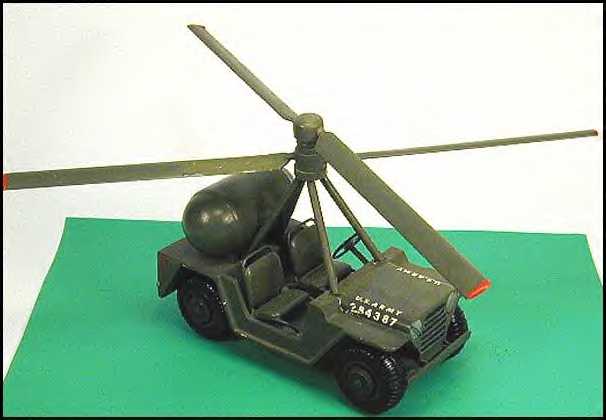
Benefits of parachutes is they can be stored when in ground mobile mode while fixed-wings/power unit(s) would have to be detached and guarded. Rotor blades can be detached and stored as the smallest stiff wings possible.
Larry Neal's Super Sky Cycle: Autogyro-Motorcycle Combo Achieves Strong Wind Air/Ground Vehicle Flight Capabilities
 youtube.com/watch?v=cPyd6g6ZKmA
youtube.com/watch?v=cPyd6g6ZKmA
The Butterfly, LLC
P.O. Box 467
109 East Main Street
Carter, Oklahoma 73627-0467
Phone: (940) 627-9887
Email: larry@thebutterflyllc.com
STILL TOO BIG A PROJECT TO START ON?
How about this? A SMALL GRIFFON vehicle, take a 4x4 All-Terrain Vehicle (ATV) and merge Autogyro or RAP flight capability to it. Put a heavily armed mounted Soldier on it, a "Dragoon". Since he can now fly, he's a "Flying Dragoon". You silence muffler the engine. His dismounted Night Vision, GPS capabilities double, or triple as mounted Air/Ground sensors. Maximum efficiency, no wasted weight. The Flying Dragoon is a very low-cost Scout vehicle that can set down on the ground and conserve fuel providing long-range staying power. Its about time that the U.S. Army take advantage of ultra-light aircraft technology and create its own unique Air/Ground platform" the Griffon.
UPDATE 2013: New Zealanders Have Created a Civilian Air/Ground vehicle!
PALV: The Flying (and Driving!) Dutchman
 youtube.com/watch?v=CajAq6ndJYE
youtube.com/watch?v=CajAq6ndJYE
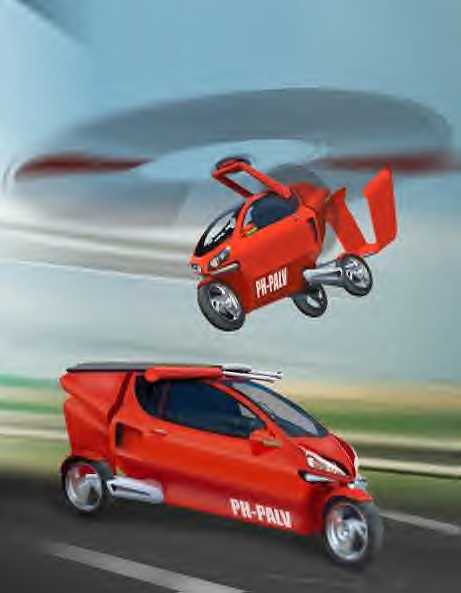
sparkdesign.nl/actueel/20041013palv/20041013press.html
The PALV - a new vehicle to lead a revolution in personal transportation
What happens if you cross a gyrocopter with a car and a motorbike?
The PALV. A personal air and land vehicle. A solution to increasing congestion in our cities, highways and skyways.
On the ground, the slim line, aerodynamic 3-wheel vehicle is as comfortable as a luxury car. But has the agility of a motorbike, thanks to its patented cutting-edge 'tilting' system. The single rotor and propeller are folded away until the PALV is ready to fly.
Airborne, the PALV flies under the 4,000 feet (1,500 m) floor of commercial air space. With land and air space reaching capacity, this is some of the last free space.
The PALV is highly fuel-efficient and powered by an environmentally certified car engine. It runs on petrol like a conventional car and can reach speeds of up to 200 km/h both on land and in the air.
Its straightforward autogyro flying technology means that the PALV is economically and technically feasible in comparison to other forms of air travel. Like a helicopter, it has a Very Short Take Off and Vertical Landing (VSTOVL) capability making it possible to land practically anywhere. It can be driven to the nearest airfield or helipad and, because it flies below 4,000 feet, can take off without filing a flight plan. The autogyro technology means that it can be steered and landed safely even if the engine fails as it descends vertically rather than nose-diving. Lift is generated by the forward speed produced by the foldable push propeller on the back.
At less than 70 decibels it is much quieter than helicopters due to the slower rotating of the main rotor. A licence to fly the PALV is more accessible than one for a helicopter or plane because of the regulations controlling autogyro craft. In the United States and soon in Europe the infrastructure is in place for 'digital freeways' that provide a safe corridor using GPS technology to aid regulation and avoid collisions for low flying vehicles.
What makes the PALV attractive is the convenience of fully integrated door to door transportation. Providing smooth transition from road to air without having to change vehicle. The versatility to allow the driver to change their mind.
Such flexibility and independence would appeal to business and recreational users alike. Its capacity to reach destinations inaccessible by road combined with ability to fly low means that the PALV has potential applications from first aid/search & rescue to surveying and observation. Or simply offers a new personal experience.
John Bakker, a Dutch entrepreneur working closely with Spark design engineering and other partners, is developing the PALV. The concept was inspired by living in one of the most world's most densely populated countries, with a can-do approach to space issues.
Private jet ownership is becoming more popular in affluent society. With further investment this hybrid prototype can pave the way for an affordable and feasible alternative. Soon private flying will no longer be the exclusive domain of executives and celebrities. If congestion or obstacles block the destination - fly. If the weather is too bad to fly - drive. Driving and flying combined in one vehicle that could cost little more than an executive saloon car.
For additional information contact Spark design engineering at: palv@sparkdesign.nl
sparkdesign.nl
or John Bakker (00316 - 53 46 80 89)
Technical data
Performance on land, Air performance, Dimensions
Top speed: >200 km/h
Max airspeed: 195 km/h
Rotary engine
Power output: 213 hp
0 - 100 km/h: < 5 sec
Min airspeed: 30 km/h
Length: 4 m
Max tilting angle: 30°
Take off distance: 50 m
Width: 1.2 m
Estimated fuel economy:
(100 km/h) 30km/litre
Min landing distance: 5 m
Height: 1.6 m
Range: 600 km
Range: 550 km
Weight: 550 kg
Fuel: 95/98 unleaded
Technical data
Performance on land, Air performance, Dimensions
Top speed: >125 mph
Max airspeed: 120 mph
Rotary engine
Power output: 213 hp
0 - 60 mph: < 5 sec
Min airspeed: 18 mph
Length: 13.12 ft
Max tilting angle: 30°
Take off distance: 165 ft
Width: 3.94 ft
Estimated fuel economy:
(60 mph) 70 mpg
Min landing distance: 16 ft
Height: 5.25 ft
Range: 375 miles
Range: 340 miles
Weight: 1200 LBS
Fuel: 95/98 unleaded
(c) 2004 Spark design engineering
Picture by John Bakker
Step 3 would be a flying Armored Personnel Carrier (APC) using today's hybrid vehicle technology which could be by lightweight electric drive from batteries charged when the vehicle is flying using its turbine engines. This eliminates having to burn up precious fossil fuel, so the "Flying APC" can stay on-station supporting its infantry fireteam. Its efficient because it doesn't require heavy transmissions connected to the fossil fuel engines and its quiet--so the enemy can't hear the vehicle. We still need fossil fuels to fly, but on the ground, electric power can get us from point A-to-B.
The hybrid technology IS ready for this...3-ton HMMWVs, 11-ton M113 Gavin APCs and 33-ton BFVs have been successfully proppelled by electric drives. Certainly a lighter ground vehicle could be so propelled...
U.S. Army TACOM Electric drive Technology Team
 BUILD-A-MODEL:
BUILD-A-MODEL:
DARPA "Flying Humvee"
fiddlersgreen.net/models/aircraft/Flying-Humvee
Flying-Humvee
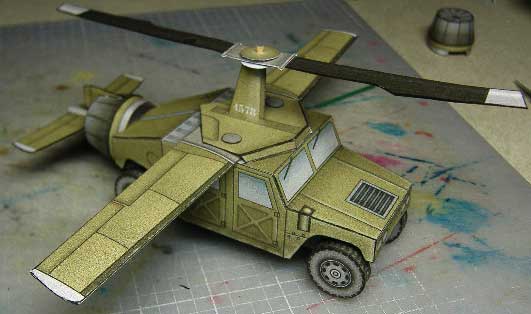
The U.S. Military has come up with more than $50,000,000 exploratory bucks for this Humvee Transformer (TX) program calling for a "robust ground vehicle" that can quickly transform into a vertical-takeoff-and-landing (VTOL). It'll have a 1,000 pound payload and a flying range of 300 miles. Yeah right !! When pigs fly.. The FG Flying Humvee is easy to build and with moving parts like a proper transformer. Large and regular versions PLUS the BumbleVee fun version- Sorry, no BW version for this model due to budget cutback.
Step 3: GO BIG--Flying APCs: Making the M113 Gavin FLY--by ITSELF = Do-It-Yourself Air-Mech (DIY-AMS)
FIXED-WING
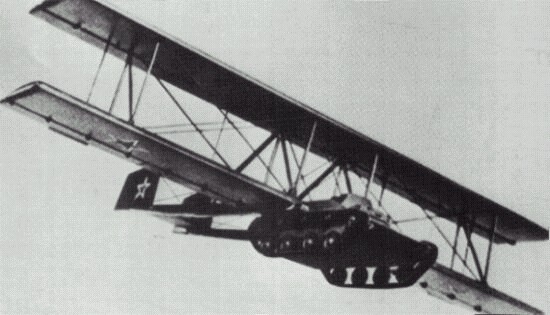
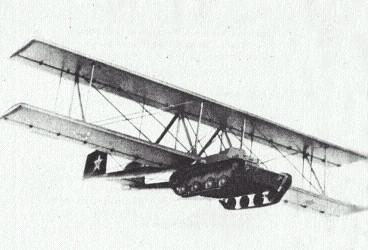

Russian KT-40 Flying Light Tank Glider
The technology already exists to make the "mother" ship M113 Gavins--a "Flying APC" aka troop-carrying, light tanks that fly--by attaching fixed-wings and a powerful prop or jet hydrocarbon-fuel engine as legendary armored vehicle designer Walter Christie wanted to do in the 1930s with a TURRETLESS tank with hull-mounted 75mm cannon--a STUG before the Germans came up with it. The Russians flew a light tank with wings towed as a glider before WW2.
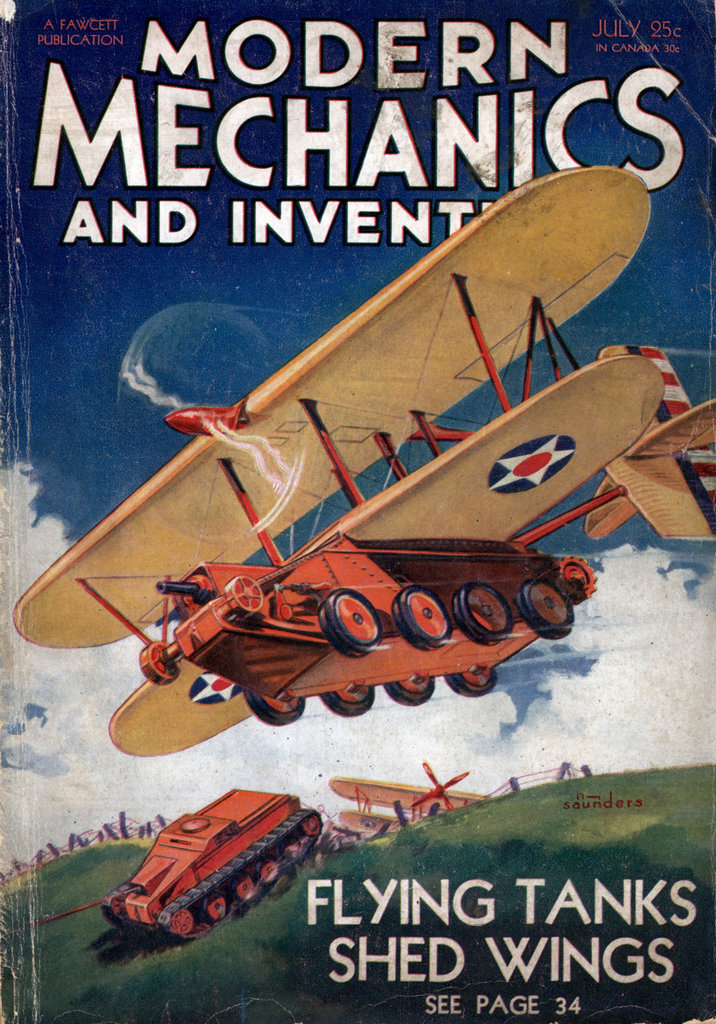
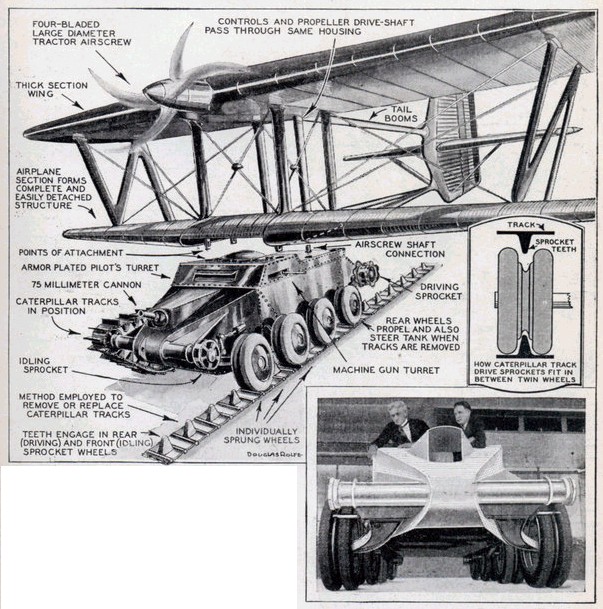
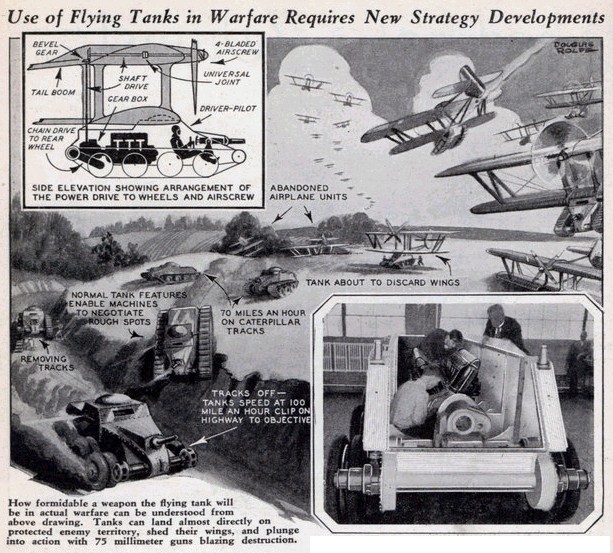

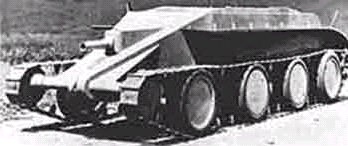
http://blog.modernmechanix.com/flying-tanks-that-shed-their-wings/
Flying Tanks that Shed Their Wings (Popular Mechanics July, 1932)By Lew Hold
Imagine those two formidable weapons of modern warfare, the airplane and the armored tank, combined into one terrible machine of destruction! Fantastic as the idea sounds, it is fast taking physical shape as a reality for Uncle Sam's army. The whole amazing story is presented to you in this important article.
IS WAR, already made terrible to contemplate by the invention of too-efficient methods of destruction, on the verge of being banished forever by an amazing new weapon so horrible in its possibilities that nations of the world will not dare to risk its fury?
This is the idea conjured up by J. Walter Christie, noted builder of tanks for the U. S. Army, who has been secretly working on the most revolutionary war invention since the discovery of gunpowder--an armored tank which flies as swiftly as a bombing plane, and which, by simply shedding its wings when on the ground, can travel over any terrain with guns blazing at speeds of 70 miles an hour!
Changes Modern War Strategy
The entire strategy of modern warfare will have to be altered when Mr. Christie's flying tank is proved practical. Trench warfare, which played such an important part in the World War, will be well-nigh impossible, for with a swarm of a hundred flying tanks descending into No-Man's Land, no infantry in the world could resist the withering fire.
Nor is the flying tank so grotesque an idea as might appear at first glance. During the late war no one even conceived the possibility of an armored tank's being propelled through the skies on wings like an airplane, driven by an airplane motor.
Flying Tank Now Being Built
Yet Mr. Christie's tank, he promises, will do precisely that. Because of his success in building speed tanks for the army and his extensive knowledge of this phase of warfare, there can be no doubt that he knows just what he is doing. He is not a man given to exaggeration, and the fact that the tank is now taking shape in the plant of the United States Wheel Track Layer Corp., at Linden, N. J., proves that the idea has advanced beyond the paper and plan stage.
In the words of the inventor, "The flying tank is a machine to end war. Knowledge of its existence and possession will be a greater guarantee of peace than all the treaties that human ingenuity can concoct. A flock of flying tanks set loose on an enemy and any war is brought to an abrupt finish."
Details of the tank's construction are astonishing. The flying fortress will be armed with a 75 millimeter gun, with supplementary small machine guns. Personnel will consist of two men. The body of the flying tank is amazingly light because of new principles of construction closely guarded by the inventor. In fact, the finished product, ready for military duty, will not weigh over four tons.
Its lightweight engine can develop 1000 horsepower, and by an ingenious system of gearing the motor drives both the back axle, for propelling the tank on the ground, and the propeller for flying duty.
Take-off Problem Solved
Eight large wheels are provided on the tank, with twin pneumatic tires over which the caterpillar tread fits. With the special springing equipment, pneumatic tires and patented caterpillar track, Mr. Christie's tank can make 70 miles an hour across rough country, it has been calculated, and as much as 100 miles an hour on a smooth surface. Its speed makes it a difficult target for enemy fire.
"It is an established fact that a single pair of wings can support this tank in the air," Mr. Christie explained to the special representative of Modern Mechanics and Inventions. "Any aviator can tell you in two minutes the exact wing spread required."
"The most serious difficulty seems to be the take-off. Several of my flying friends have told me that many army planes require three-quarters of a mile of prepared ground for a runway and they insisted that my machine would need a still greater starting space. There were also those who doubted that my tank would even leave the ground."
"After three years of experimentation, I was prepared to meet their queries and their doubts. This is the solution: My machine will work up to a flying speed while it is still on the ground. At a hundred yards the tank will be going fast enough to rise the moment the power is transferred from the wheels to the propeller, no matter on what kind of surface the tank is traveling."
"The caterpillars will function on any condition of base. The Christie speed tank which has been already acquired by the United States government bears testimony to that advantage."
Treads Simplify Landing Problem
"The other hazardous stumbling-block, the landing of the flying tank, has also been overcome. My machine can alight on very limited space. The pilot can observe his air speed by means of his instrument board. When he switches from being a pilot to being a chauffeur he will know his land speed, both on the caterpillar tracks and on wheels, whichever he may choose to bring into use.
"All that the man at the controls has to do is to start the wheels of the caterpillar in motion and adjust them to the air speed. This is done merely by keeping an eye on the speedometers. As soon as the tank touches the ground, he brakes it as he would an auto truck. If he wants to liberate the tank from the wings, he has only to press a lever and that operation is completed in a jiffy. Then if he wants to, he can proceed along a highway on the rubber-tired wheels at a rate of 100 miles an hour."
That is how Mr. Christie's latest invention will work. But he has already begun to plan for a further improvement on this device. He will soon begin work on a detachable airplane as applied to the armored tank. The plane will deposit the tank at a desired post and then return to bring up others, or engage in other maneuvers.
In connection with these latest experiments, a valuable peacetime use of the flying tank principle suggests itself.
One of the several problems confronting passenger air lines today and, from the passengers' standpoint, certainly the most annoying, is the business of getting passengers to and from the airportâ€"the actual point of arrival and departure of the airplane itself.
Airports are perforce located at a considerable distance from the downtown district of a city and it naturally follows that the larger the city the more inaccessible will be the airport or air terminal. In the minds of prospective air passengers the immediate accessibility of bus and railroad facilities contrast pleasantly with the annoyance attendant on purchasing a ticket, riding out to a field, transferring to a plane and repeating the performance at the flight destination.
The time-saving feature, most practical appeal of air travel, is thus not so much in evidence or even may be totally absent in flights of less than 300 miles.
Bringing Airports Close to Town
Several remedies for the situation are feasible. One, and the most frequently heard of, is to build airports in the heart of a city, by utilizing the tops of large buildings with or without the aid of catapult launching devices, by spanning whole blocks of streets with wide bridge-like structures or spanning convenient rivers in a similar manner. All these ideas have been mentioned at different times. All of them suffer from one common disadvantage.
To bring an air terminal into the heart of a city would not only result in air traffic at an altitude we are obliged to regard as unsafe, but would further imply taking off and landing over these crowded centers. The airplane of today is hardly suited to operating under the conditions just outlined and therefore this otherwise attractive solution of the problem must, for the time being at any rate, be abandoned as a serious consideration.
Another course is open and fantastic as it may appear at first glance the idea has been approached a number of times and there are no serious difficulties in the way. The idea involves the building of passenger planes in two distinct and self-contained units. One, the airplane portion, would contain all the essentials for flight and consist of wings, tail surfaces, motors, pilot's control room and the landing gear.
The passenger cabin complete would form a second separate unit. Capable of being attached or detached automatically from the airplane unit, this cabin would have the appearance of a large bus or Pullman car and would be capable of independent operation on the ground by means of a light motor driving wheels which would be drawn up when cabin and plane formed a single flying unit.
Such a combination would enable passengers to enter the cabin at a central depot in the city itself, travel out to the field (in extremely large cities where the passenger traffic justified the expense, on special roads) and there be instantaneously attached to the airplane portion of the combination to proceed by air to its destination.
Leaving our baggage at the checking counter, we then repair to the excellent restaurant to obtain a light meal and pass the time until our plane time arrives. As the time approaches for the plane-car to leave we retrieve our baggage and pass through the door to platform No. 5, to see immediately before us a smooth metal buslike car into which passengers are now pouring. A capable attendant relieves us of our baggage and we enter the car and pass along the central corridor to the small but comfortable observation room in the rear.
Glancing through the windows which surround this compartment, we notice numbers of other plane-cars. Some are standing at their respective platforms, others are arriving or departing through the low doorless exits of the vast hall. At 5:15 to the dot our car glides smoothly forward and we pass out of the hall onto a wide high-speed road which leads directly to the flying field.
Travelling at an even sixty, we arrive at the field to see a number of curious looking planes lined up before the service hangars. They appear to be all wings and tail and are lined up over sets of trough-like tracks which serve to guide the wheels of the cars into exact position as they arrive to be hooked up to the plane units. Into one of these sets of tracks our car wheels presently glide, the car stops and the ground crew busies itself locking the connections into place.
A few moments pause and then the motors of the plane, which have been idling as we approach, burst into a mighty roar and in what seems to have been but a few minutes since we entered the car at the central depot we are sailing high over the city on our way to Minneapolis.
Descending at the Wold-Chamberlin airport at Minneapolis our wheels have scarcely touched the ground and the plane approached the concrete apron before the landing gear is retracted, the car wheels extended and the release gear operated to allow our. car to shoot forward on the ground once again under its own power while the airplane unit is run into the service sheds to await the car's return with a fresh load of passengers for the return flight. Minneapolis air traffic being insufficient to justify the expense of a special speed road we proceed along the ordinary highways and city streets to the loop district and pull up inside the central depot to leave our car exactly three hours from the time we entered it in the Chicago central depot.
A flight of fancy? Perhaps. But not beyond the bounds of possibility. Until such time as planes are capable of arrested flight or are so dependable that they may be operated from the heart of a great city without undue risk to either passengers or inhabitants, this may well prove to be the most satisfactory solution of the airport problem. It is true that the necessity of taking passengers to the field has not been eliminated but the inconvenience element has been totally done away with and furthermore, in the case of large cities where the volume and radius of travel warrants the expense, high speed airport roads will permit the cars being shuttled back and forth at speeds quite impossible under present conditions.
A modification of the detachable car unit described in this article would lend itself admirably to freight purposes. In this case the freight cabin or car need not be equipped with motor or ground wheels but could be detached directly onto skeleton trucks or trailers for distribution at the terminal airports.
Still another application of the idea would be of inestimable value to sport planes. Arrived at a field the owner-pilot could detach and park the airplane unit and proceed in what would then become a lightweight closed car to his city destination. The car in this instance would in all probability resemble the little three-wheeled "tear-drop" car illustrated in the April issue of Modern Mechanics and Inventions.
To make the AeroGavin fly as a Short Take-Off and Landing (STOL) air/ground vehicle by parachute or fixed-wing means is just a matter of adequate funding to pay for the R&D. To make an AeroGavin take-off and land vertically would take more effort to create an autogyro system but is feasible if we have the courage and imagination to do so. AeroGavins with air/ground maneuver capabilities would fulfil British Brigadier Richard Simpkin's Race to the Swift dream as well as well as give General Gavin's KIWI concept wings--literally. Meet the AeroGavin:
 http://youtu.be/24Rr03hqDec
http://youtu.be/24Rr03hqDec
Ground maneuver units that can FLY THEMSELVES don't have to "mother, may I?" beg airlift from fly boys in separate unit bureaucracies which takes time and loses opportunities to win battles. Do-It-Yourself Air-Mech (DIY-AMS)
FLYING APC ON THE GROUND
The flying APC might be 5-roadwheeled like the Gavin, the roadwheels/tracks in aerodynamic sponsons blending into a composite armored body (proof against small arms fire and able to accept applique' panels) with rear ramp, be able to swim without preparation across inland waters and travel x-country. It would be shaped like the RAH-66 Comanche to be radar-invisible and low-signature. The left-seat crewman "drives" the vehicle and the right crewman stands on his seat and "Vehicle commands" with his head out his top hatch and mans his Heavy or Medium Machine Gun. 2 of the dismount infantry in the back can stand on the left/right bench seats up through their left/right top hatches and face outboard with 5.56mm weapons. In addition to the roof-mounted M/HMGs, on the ground the Flying APC would be able to employ its winglet mounted weapons (EFOGM, 2.75" Hydra-70, Hellfire ATGMs, 30mm ASP cannon pods) using the MMS from a hull down position. The winglets can raise/lower for elevation/depression and the stores stations can deflect left/right. While not as responsive as a 360 rotating turret, its good enough. If a turret is a must, it could be built AROUND the engine hump on the roof to contain a small 30mm ASP cannon with careful gas venting to not interfere with air flow into the engine(s).
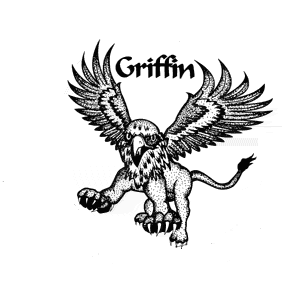
ROTARY-WING
HOW THE Luftpanzerjaeger "FLYING APC" FLIES
I know that the reader is already wondering how this machine will fly and perhaps is in serious doubts as to its feasibility. But I wanted to work from the ground up--from its application first and then to the air details.
The rotary-wing, Flying APC would NOT be a helicopter, it would be an AUTOGYRO.
Carter Copter's 400mph autogyro
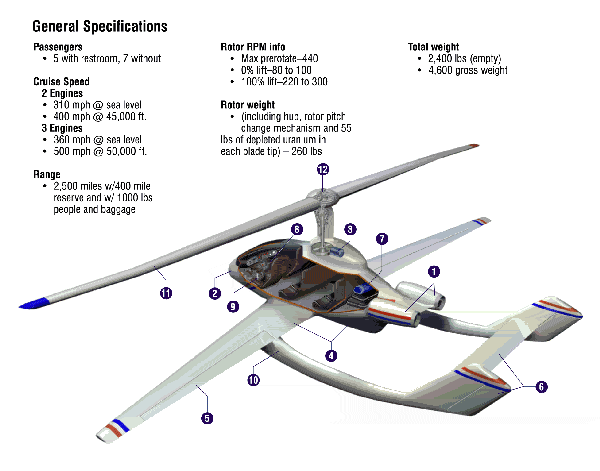
CarterCopter Diesel 200 mph Gyroplane with Folding Fixed-Wings
 youtube.com/watch?v=Fv-_HpoB-_c
youtube.com/watch?v=Fv-_HpoB-_c
Colonel Franz's mistake is he wants a helicopter to be the means for his AirLand Vehicle to fly. Helicopters are heavy and complicated in themselves, leaving little payload left that can be used to be a ground vehicle. What we need is the bare minimum means to fly--rotors and jet thrust. This means a set of free spinning rotors, not a complicated power driven helicopter rotor and transmission. It would be propelled forward by its turbine engine exhaust in the tail. That's it. No anti-torque rotors. No transmissions. No complicated gearboxes. The Autogyro is the safest flying machine ever made because it cannot stall---fixed wing planes must keep going forward to fly, without it they start going down, if they are too low they crash. If they pull up and stall they fall to the ground like a rock and crash/burn. Helicopters only stay flying as long as power turns their rotors. The minute power is lost to the helicopter's rotors, it can AUTOrotate like an AUTOgyro if it can be declutched from the engine transmission. The only thing an Autogyro can't do is hover in the air at 0 mph--it must keep moving at 15 mph to keep spinning its rotors, the minute it slows less than 15 mph it begins to settle down gently to the ground in AUTOROTATION. We do not need to hover for the Flying APC. With an Autogyro flight system, the flying APC can take off vertically by clutching the engine to the rotors for initial take-off, and then declutching for forward flight. The pitch on the rotors can be flattened so there is less drag, making it possible for it to be a "Gyrocopter" to fly at speeds 250-500 mph using bolt-on wings; allowing it to fly long distances across the ocean for strategic/operational mobility. Unlike the V-22 which has to tilt its rotors for slow-speed flight, the Autogyro can fly terrain contour/Nap Of the Earth (NOE) flight at 15-50 mph to avoid enemy detection. The Autogyro can land vertically.
The return of the COUP DE MAIN: the rotary-wing glider----

The Autogyro can turn its engine off short of the target and SILENTLY approach its target--just like WWII gliders did, with tremendous success at Eban Emael, Normandy, Pegasus bridge, and Operation Varsity. The beauty of the Autogyro flying APC is it doesn't have the drawbacks gliders have. It can fly it and its men OUT once the mission is done. If things don't look good to land, it can turn its engines back on and fly away, whereas with a glider once you are going down, there is no turning back.
On the ground, the Flying APC, stops its rotors with a brake. The two dismount Soldiers pop open the top roof hatches and disconnect the rotors and stow them along the top roof, adding a measure of roof armor protection as an added benefit. The tail boom with the exhaust of the turbofan telescopes back into the vehicle body by the flick of a switch. The VC opens his top hatch and places his H/MG on its ring mount. The left crewman turns a switch to change the vehicle's computer to ground vehicle mode, making his wheel turn the front and rear set of wheels and not the winglet ailerons. In/out on the wheel still raises or lowers the angle of attack of the winglets for elevation. Deflection is controlled by the orientation of his helmet AH-64 Apache style. The VC can also control weapons through his helmet sight on over-ride. He would have a flip down TV screen to control by joystick the Enhanced Fiber Optic Guided Missiles (EFOGMs) when they are launched. Other armament would be laser-guided Hellfire ATGMs, 2.75" Hydra-70 rockets, 30mm ASP cannon pods, and Stinger Anti-aircraft missiles depending on the mission requirements.
WHAT THIS ALL MEANS?
Chitty, Chitty, Flying Humvee: DARPA Making Commander Ian Fleming's Dream Come True!
 youtube.com/watch?v=iUKFE-UWaN8
youtube.com/watch?v=iUKFE-UWaN8
You are probably in a state of shock because what has been described is not only feasible--its going to happen, either by us or someone with more gumption.
The dreams of the AIRmechstrike visionaries are now possible thanks to hybrid fossil fuel/electric drive being made practical. Autogyro flight systems have been with us longer than there has been helicopters but were neglected because of the sex appeal of hovering flight. If we are trying to rescue someone we will LAND with the Autogyro and then take off again. If this is not possible, a slow circle overhead might allow a team to hook up to the Autogyro's Fast Rope Insertion/Extraction System (FRIES) rope dangling below if they are wearing a Tactical load Bearing Vests with a "donkey tail" and locking-d ring carabiners to connect to the rope's loops for this purpose. Light plane pilots in WWII used to fly in circles overhead jungle clearings to pick-up messages with a line and hook which would stay more or less stationary the closer it got to the ground.
What this means is nothing short of revolutionary.
Its own Strategic Transport
The Flying APC Airmechstrike force can self-deploy from CONUS to any place on earth at speeds up to 500 mph. This means no dependence on the USAF for transport aircraft. Sorry. They can be used to move the other parts of the Army's combined arms team.
Like the Rhodesian FIRE FORCEs mentioned in the beginning, there will be still a need for lots of Paratroops to be airdropped to work in conjunction with the infantry organic to the flying APCs, since at 4 men at a time, it would be cost prohibitive to move large numbers of men this way, the point is that the synergy of the man to this combination ground/air machine enables a superior SENSOR/SHOOTER capability to get the initial "drop" on the enemy.
AIR and GROUND Operational/Tactical
Once in the area to conduct combat operations, the Flying APC can drop off its 4-man fireteam to operate separately and stay in flying condition, using its weaponry as a helicopter gunship. In this mode, its like a Hind or armed Blackhawk helicopter except stealthy and faster. It can also scout for the men on the ground or other attack helicopters like an OH-58D or RAH-66 scout helicopter. The beauty here is that there is no separate Aviation unit to coordinate and beg/threaten/coerce to get lift assets to enable AIRmechanized maneuver, this capability is organic to the infantry or "Flying Dragoons".
Ground-Ground Operational/tactical
Or as in the Rhodesian long-range, deep in enemy lines scenarios, the Flying APC lands and acts as a light wheeled armored vehicle.
The men can stay mounted, standing upright through top hatches, weapons at the ready, with extremely heavy firepower available to destroy the enemy on contact. The MMS allows the vehicle to see above the trees from a safe hull-down position. This includes long-range attacks from 1-10 kms using EFOGMs fired from the elevated winglets.
The infantry can dismount, and then move forward on folding bikes/carts or on foot to scout or assume ambush positions employing automatic weapons, rifle/hand grenades, rockets and Javelin fire/forget ATGMs.
If the Flying APC Fire Force wants to break contact to continue the mission from a different location, they can remount the vehicle and drive overland using electric drive or re-attach the rotor blades and FLY to a new location or back to base, mission complete. By being able to fly, the Fire Force can penetrate deep into the enemy's rear areas and bypass his defenses, mines, obstacles and/or natural obstacles like rivers, cliffs, thick vegetated areas, cities etc etc. But once the man/machine is where it wants to be, the machine doesn't have to go away and fly back to base, stranding the men, or run out of gas trying to loiter in the area..it can transition itself into a ground vehicle---get back on the ground and save its fuel--and most importantly function on the ground and contribute to the fight as a wheeled APC.
ENTER THE BEAN COUNTERS...
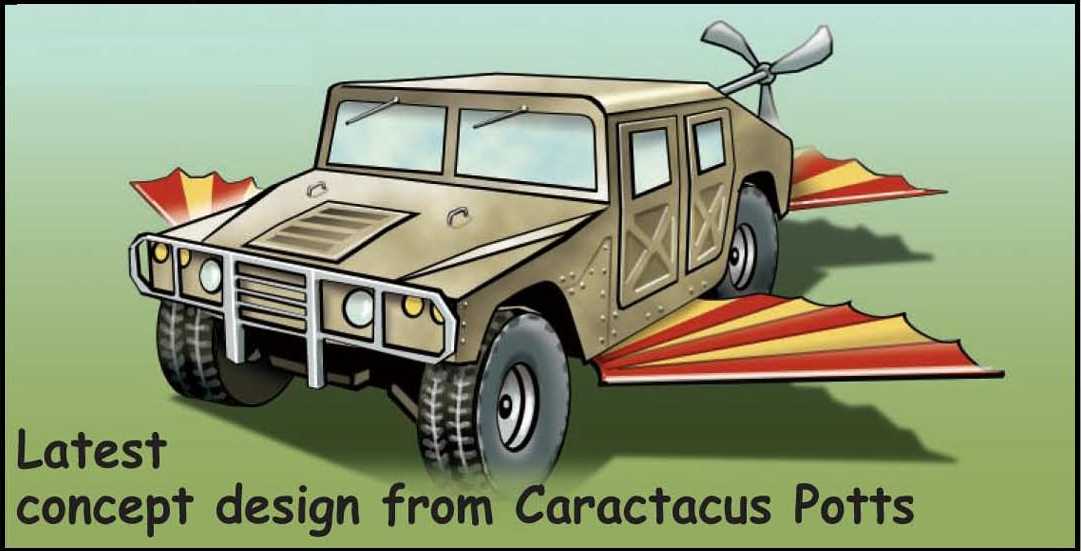
Now the opposition to the flying APC will be from the people who's "turf" they feel will be infringed upon. The USAF airlift community because we wouldn't need them to fly Army helicopters to OCONUS areas. The USAF fighter jocks because the Army could do its own CAS at high-propeller aircraft speeds. UAVs are going to take manned CAS over in the USAF's warped minds, anyway. The Army's transport and attack helicopter folks by a diminished need to have to beg them to come and participate in combined arms AIR-MECH-STRIKE 3D warfare. The marines because it will prove to the world that their V-22 which can't even carry a HMMWV much less an armored vehicle is a multi-BILLION dollar flop and that they are hardly an elite force at 172,000 and only able to field 3 battalions afloat at any time in a world that needs answers in HOURS not days, weeks, months via a "slow boat to China". Instead we BUILD THE APC INTO THE FLYING MACHINE ITSELF, that way we can't conveniently block our light forces from getting armored vehicles like the Mc CENTCOM Commander did to TF Ranger in Somalia in 1993. And then of course, the target audience, the beneficiary of the Flying APC, the Army's infantry will not likely want it, because they are stupid, stick-in-the-mud types bent on demonstrating their penis size-proportional-to-the-rucksack-they-are-carrying on foot at less than 1-4 mph mentality.
But here the "bean counters" can come to our aid, because simple math shows an aircraft that does 2 things is cheaper than a ground vehicle AND an aircraft to move the ground vehicle. Efficiency in physics translates into greater mechanical advantage and battle-winning force on the battlefield--IF--we can overcome the stupidity of the institutional egos involved. By starting SMALL---we are only asking for a light strike helicopter that is an electric 6x6 ATV carrying 4 dismounts, we have the laws of physics on our side. At this weight/size range, we can make ANY object shape fly. Why not make that object an AT ground vehicle? Why have it a fragile, hanger baby on skids or itty-bitty bogie wheels? Within this weight/size constraints, we can truly build a light AFV to be the body/shape of the flying machine.
HOW DO WE START?
We could start with a UH-60 Blackhawk helicopter and making it an Autogyro and a ground vehicle.
Remove the entire tail and transmission. Replace the landing gear with two sponsons with 3 all-terrain tires, the front/rear axles pivot for steering, connected to an electric drive motor. Have the electrical batteries recharge by the spinning of the rotors. Change the rotors to lighter types that can be easily removed and stored along the top roof during ground vehicle operations. Remove all the helicopter plumbing and replace with a simpler Autogyro flight system. Put a MMS system on top the rotor head from an OH-58D Kiowa Warrior.
The Blackhawk already has ESSS winglets for ordnance to be fired from it, and side mounts for machine guns. Troops leave out side sliding doors.
Design and fit a retractable tail for flight control and the jet exhaust.

GROUND-MOBILE AIRCRAFT: A MD520 NOTAR "Little Bird" Air/Land/Sea Scout Vehicle?
OK, imagine you are in a Little Bird helicopter. I prefer NOTAR. You can use a tail rotor type if you like.
You have entered the battlefield from the air.
You haven't spotted the enemy but you know he's around but if you keep flying you have to return to base.
So you pick out a hide site and land.
You fold your rotor blades.
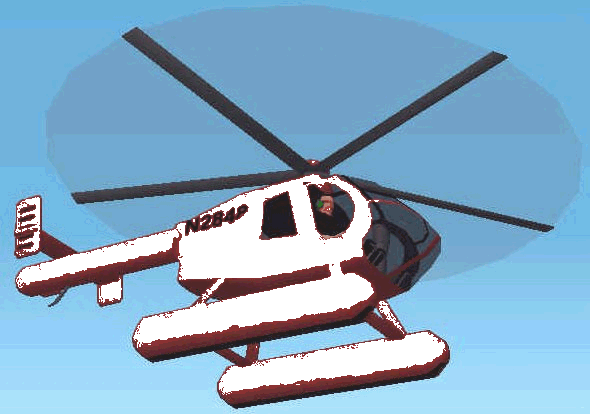
On your left and right skids are rubber tracks powered by electric hubs via a battery pack charged by your turbine engines. The roadwheels float if you land in water.
With your turbine engine in idle you engage the tracks and drive across country like a tracked ground vehicle into your hide site.
There you shut down your engine and throw a camo net over your Little Bird but have battery power run your mast head Image Intensifier and FLIR sensors all night looking for the enemy.
At 0300 hours, the enemy is detected: a 6-man sabotage roadside bomb team. Your scouts engage with assault rifles and rifle grenades and kill 2 but the other 2 flee.
You uncover the camo net, throw it in the back. Unfold the rotors and crank up the turbine engine.
The Little Bird takes off and you pursue the 2 bad guys running for the border. You see them on the FLIR ball and engage with 2.75" Hydra 70mm rockets. They are blasted to bits.
Mission accomplished.
You fly back to base as your relief Little Bird appears on the dawn horizon.
FYI, Robert Fulton wanted to add TRACKS to his AirPhibian aerocar to maker it a scout tank for the U.S. Army:
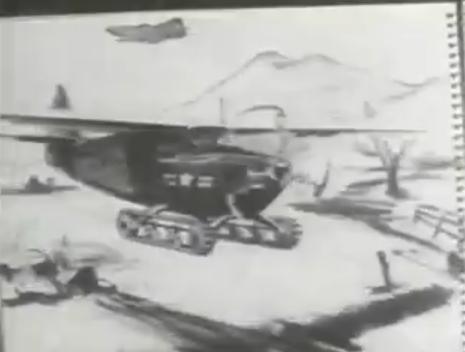
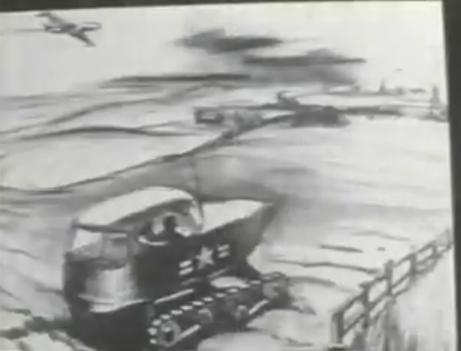
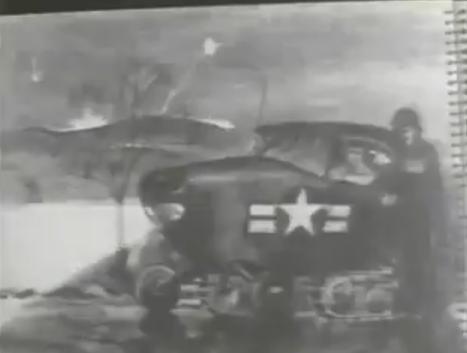
Ground Mobility is Key" You Can't Fly 24/7/365
So essentially, if AIRCRAFT FOLD THEIR WINGS---or in the fase of rotary-wings detach if necessary---if their LANDING GEAR is sturdy enough they can be TOWED by ground vehicles or even placed INSIDE ISO SHIPPING CONTAINERS aka "BattleBoxes" and moved on land that way.
 BUILD A MODEL
BUILD A MODEL
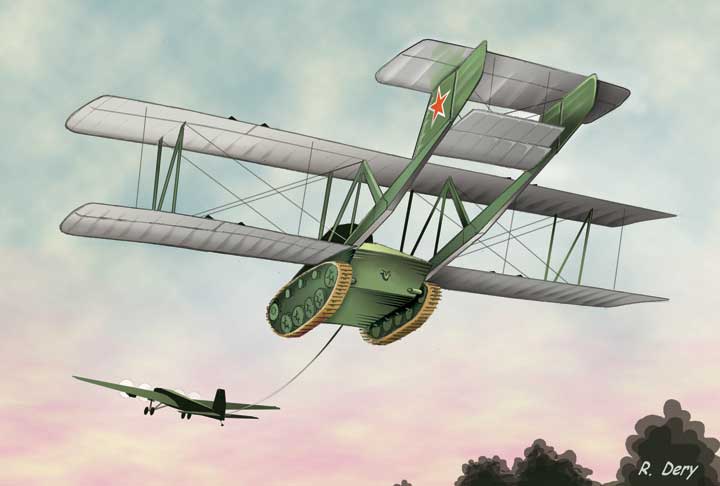
RESIN
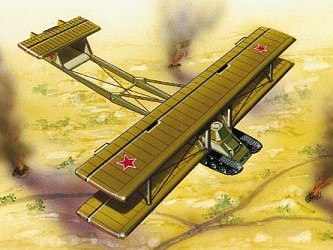
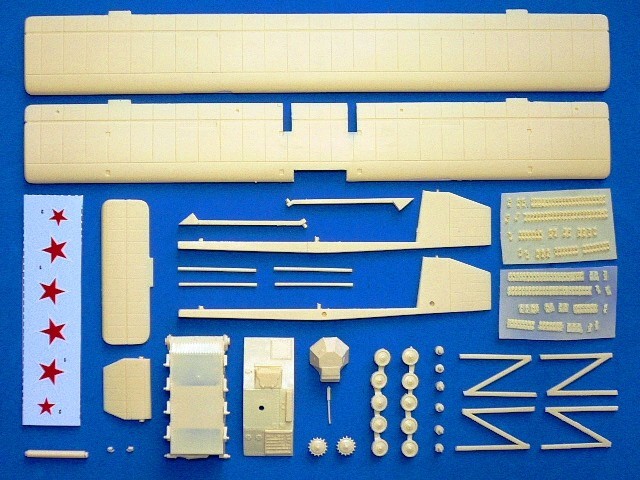
In 1932, the Soviet high command requested many new concepts of the airborne warfare for aerial close-support to the army. That was included dropping an armored vehicle from the sky to support the parachute troops. The original concept was converting the 32 tons tank, T-34 into a glider and towed by a pair of Ant-20bis as tugs. In 1939, Soviet airborne force considered to try the light-weighted tank, T-60 for the experiment, and selected Antonov OKB for the glider design. The prototype was started in 1941, and was given designation A-40, KT which meant "Kryl'ya Tanka" (winged tank). The tank was lightened for flight test by removing the armament, the signal light and the tracks fenders. The first and only flight was made by tow from TB-3 in 1942. The test was judged successful with smooth landing, but the test pilot (who also performed as the tank driver) doubted that it would be lack of control if fly by the full-loaded tank. As the real need was to fly in the heavier T-34, and also due to the shortage of the tow aircraft, the KT project was cancelled.
Type: Experimental flying tank glider
Purpose: To explore to fly the loaded tank and down at battlefield
Span: 18m.
Length: 12m.
Height: 3.8m.
Engine: None
Max.speed: 75 mph (towing speed)
Crew: 1 (Test pilot)
Armament: 1x 20mm TNSH cannon / 1x 7.62mm TD machine-gun
PAPER
Flying-Tank-A40
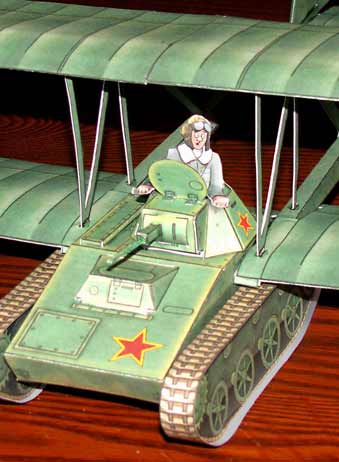
Built around the lightweight T-60 Soviet Tank, the Antonov A-40 KT barely got off the ground....If there would have been a powerful enough tow plane it may have been successful. The development of large gliders and transports put an end to the Antonov A-40 KT. Kit includes both version of the T-60 tank. With a little ballast in the nose of the tank, this beauty actually FLIES!!! $9.95
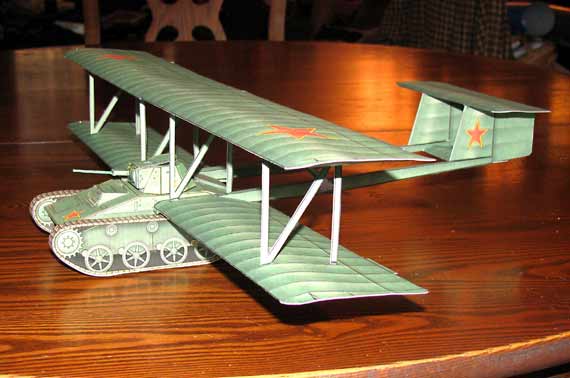
FLY--and DRIVE--A R/C AIRLAND VEHICLE!
Amazing Flying DARPA Humvee R/C Model!
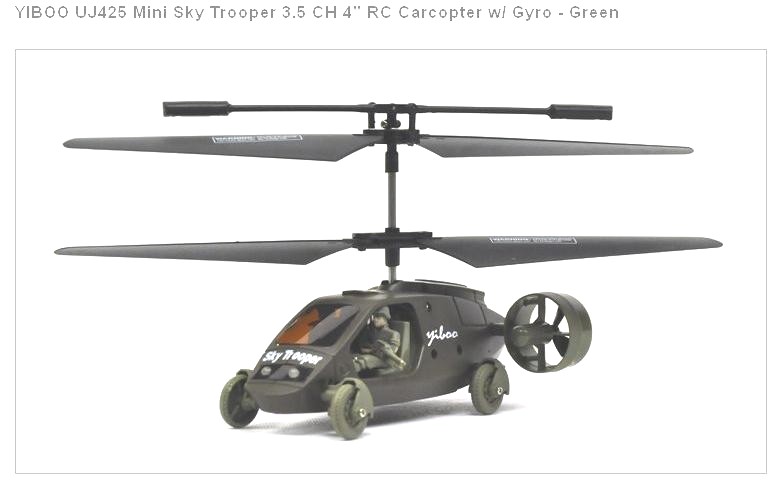


ujtoys.com%2FUJ425-Mini-Sky-Trooper-3CH-RC-Carcopter-Green-p%2Fuj425-g.htm
Price: $54.99
Sale Price: $39.99
You save $15.00!
Description:Dual function modes - drive or fly
3.5 CH Flight: Flies up and down, left and right
3-channel Drive: Drives forwards and backwards, left and right
Double propellers (one rotating clockwise, the other rotating anticlockwise) coupled with a built-in gyro stablliser offer an easy piloting experience that's great for beginners. Infrared tri-band function (A,B,C) allows three users to fly simultaneously without interfering with one another's signals Control lights function - turn on/off
ARNHEM RE-THINK: What if XXX Corps Had Flying Light Tanks?
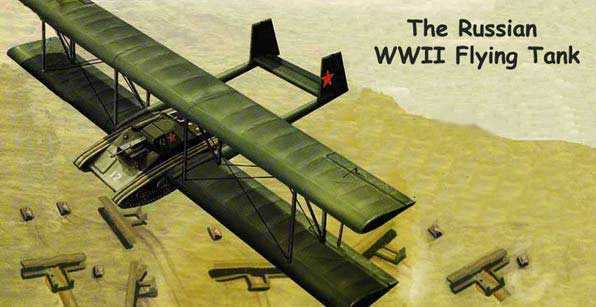
It's undeniable that the 6th British Airborne's Recce Squadron with Tetrarch light tanks were available for the mission to seize Arnhem bridge and could have landed by Hamilcar gliders, then sped to the north end of the Bridge bringing 2 more paratroop battalions to reinforce Frost's men, holding out long enough for even the sluggish XXX Corps to arrive. However, this reality also brings home a WARNING that bureaucracies are inherently opposed to doing what's the best and most in favor of doing what's the least and easist; resulting in disasters. The LESSON LEARNED here is to not have to mother may I? needed combat arms, but instead own and operate them--as cavalry units figured out decades ago.
So imagine for the moment the bureaucracy will not let you have either the light tanks or the gliders or the aircraft to effect 3D maneuver. Just open your eyes and look around; that's the situation today.
Now back to 1944.
WHO does have light tanks participating in Operation MARKET-GARDEN?
Why of course, XXX Corps.
But you have no gliders and even if you did, no aircraft to tow them. Now let's do some revisionist history.
One of the mysteries we haven't solved yet is what ever happened to Walter Shristie's flying tank? He was the subject of a Modern Mechanics magazine article and photos show a prototype being made in the 1930s. Imagine instead Christie continued and perfected his aero unit that could attach to a light tank under 20 tons and make it fly. Now imagine you are XXX Corps blocked from reaching Arnhem bridge by German troops exploiting the single road flanked by swamps. Though you (Montgomery) can--and should ask your brother-in-law General Percy Hobart for some of his "funny" amphibious tanks, say for some reason you can't get them.
What do you do?
You attach Christie's aero units to a force composed of your crews in M5 Stuart light tanks obtained from the Americans via lend-lease, and you have them do-it-yourself (DIY) 3D maneuver over the Germans say around 0300 in the morning when they are least alert, land on the south side of the bridge, detach aero units and fight across to link up with Frost and Urquart's men holding the north side. In other words the losers who whine about a flying tank not being able to out dogfight a Me109 don't get it--an AeroTank Cavalry with an ability to leap across short distances and then continue ground maneuver isn't going to be at 20, 000 feet tangling with enemy fighters. It just needs to break contact with the Earth and fly over natural and man-made obstacles (the enemy) to effect maneuver terrain leverage (MTL) to win the fight. Once Arnhem bridge was secured, the German's fate would be cooked as the allies poured into their industrial heartland--shortening the war by at least 6 months--if not a year--and preventing any "Battle of the Bulge" counter-attack from even happening.
The point here is to always have the means to fly your light tanks--to DIY air-mech-strike maneuvers--and not rely on any bureaucracy to fight smart..
FEEDBACK!
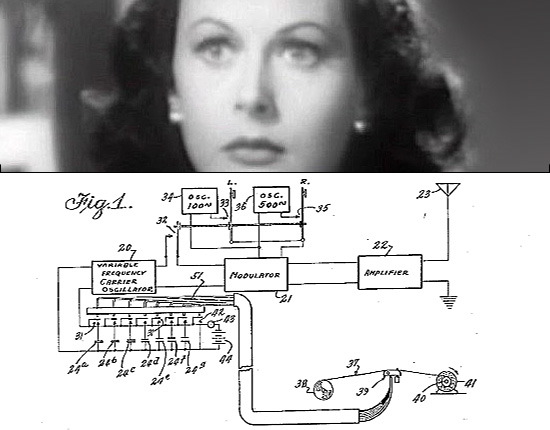
An Army Aviation expert writes:
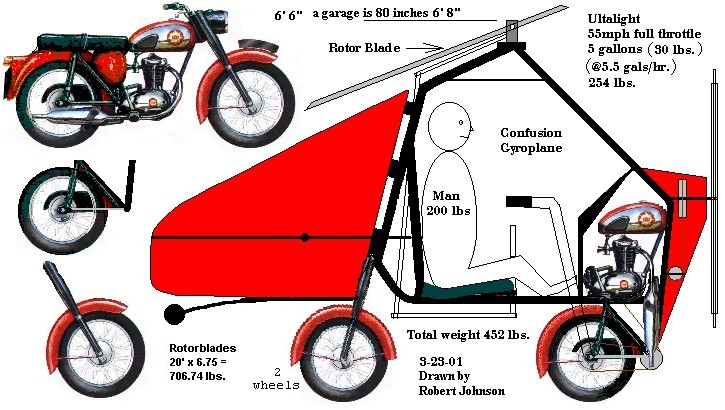
"Now you're talking. it might be a little too 'challenging' for the pilot/trooper to land on two wheels, which is why I'm thinking more along the lines of a 4-wheel ATV configuration. but give the guy good binocs, NVG, and a radio, and let the FA take care of business. maybe a laser designator too.
I've heard lots of good things about MLRS, and from what I understand the U.S. has always had a really good artillery system. sounds like we lack an artillery-launched anti-tank missile, though. that would be just the thing in this situation, where a deep-penetration scout could call 1-800-ARTY4ME and really put the hurt on enemy armor and transport columns.
This may be a bit too ambitious, but I see a need for a next-gen shoulder-fired missile that serves as anti-aircraft and general anti-vehicle. should be about the size of a Stinger, but with a multi-purpose warhead. fire-and-forget design. Could be used by leg infantry, light wheeled scouts, and rotorcraft from your gyro Dragoon up thru Apaches."
Flying Jeeps
"Two completely separate projects to build self-supporting flying jeeps were undertaken, namely the 'Rotabuggy' conceived by George 'Mickie' Walker at Sherburn-in-Elmett in England, and the other known as the 'Fleep' designed and built by the Directorate of Inventions for the Australian Army. Both were remarkably similar in having a tubular framework supporting an autogyro rotor assembly, the Rotabuggy having a twin-blade configuration and the Fleep a three-blade rotor. Aerial stability when towing was provided by an H-shaped tail on both jeeps. The Fleep had an additional aerodynamic fairing added to the front of the jeep. The Rotabuggy's windscreen was removed and replaced with a streamlined 5-panel facet of presumably glass or perspex. Although the Australian Fleep was cancelled before it had a chance to fly, the Rotabuggy's first flight occurred on 27th November 1943 when it was towed behind a Bentley. Using a driver to control steering on the ground and a pilot sitting in the jeep's passenger seat to handle airborne tasks, it was soon discovered that the most difficult aspect of flying was coordinating the landing. A maximum speed of 115 km/h (72 mph) was successfully achieved after towing behind a Whitley bomber, but the low flight speed almost led to the the tow aircraft stalling.
In both cases, territorial advances by the Allies in New Guinea and the success of D-Day, as well as the use of glider landings with fully-equipped normal jeeps and crews removed the need for Airborne jeeps and both developments were cancelled.
A plan and profile line drawing of the Rotabuggy, suitable for modelling, appeared in FlyPast magazine, January 1993. Another article, 2 1/2 pages with scale 3-views appeared in AIRFIX Magazine, November 1970 by Geoffrey W. Futter on how to convert the Airfix 1/76 jeep into a Rotabuggy."